
A member of the Chinese delegation (R, front) speaks after the inscription of the Beijing Central Axis on the World Heritage List by the United Nations Educational, Scientific and Cultural Organization (UNESCO) during the 46th session of the UNESCO World Heritage Committee held in New Delhi, India, July 27, 2024. UNESCO on Saturday announced the inclusion of the Beijing Central Axis: A Building Ensemble Exhibiting the Ideal Order of the Chinese Capital, into its world heritage list. (Xinhua/Javed Dar)
By Chen Dongshu, Shi Yucen
NEW DELHI, July 27 (Xinhua) -- The United Nations Educational, Scientific and Cultural Organization (UNESCO) on Saturday announced the inclusion of the Beijing Central Axis: A Building Ensemble Exhibiting the Ideal Order of the Chinese Capital, into its world heritage list.
So far, China has a total of 59 World Heritage Sites.
Beijing Central Axis, initially established in the 13th century and formed in the 16th century, runs through the old city of Beijing from north to south. It has become the longest urban axis in the world today, spanning 7.8 kilometers.
The heritage area of the Beijing Central Axis covers 589 hectares, with a buffer zone of 4,542 hectares. Its location, layout, urban form, and design reflect the ancient Chinese tradition of urban planning, serving as an important emblem that highlights the distinctive characteristics of Chinese civilization.
The UNESCO World Heritage Committee recognized the integrity, authenticity, and protection and management status of the Beijing Central Axis. It also acknowledged the area's continued role as a social and political center in Chinese society.
The committee believed that the Beijing Central Axis represented a unique type in the history of world cities, embodied traditional Chinese philosophical concepts of "Zhong" (centrality) and "He" (harmony), and made significant contributions to the history of urban planning worldwide.
The organization also highly praised the Chinese government's tremendous efforts and outstanding achievements in protecting and preserving the cultural heritage of the ancient city of Beijing. ■

Members of the Chinese delegation celebrate the inscription of the Beijing Central Axis on the World Heritage List by the United Nations Educational, Scientific and Cultural Organization (UNESCO) during the 46th session of the UNESCO World Heritage Committee held in New Delhi, India, July 27, 2024. UNESCO on Saturday announced the inclusion of the Beijing Central Axis: A Building Ensemble Exhibiting the Ideal Order of the Chinese Capital, into its world heritage list. (Xinhua/Javed Dar)

Delegates greet members of the Chinese delegation after the inscription of the Beijing Central Axis on the World Heritage List by the United Nations Educational, Scientific and Cultural Organization (UNESCO) during the 46th session of the UNESCO World Heritage Committee held in New Delhi, India, July 27, 2024. UNESCO on Saturday announced the inclusion of the Beijing Central Axis: A Building Ensemble Exhibiting the Ideal Order of the Chinese Capital, into its world heritage list. (Xinhua/Javed Dar)
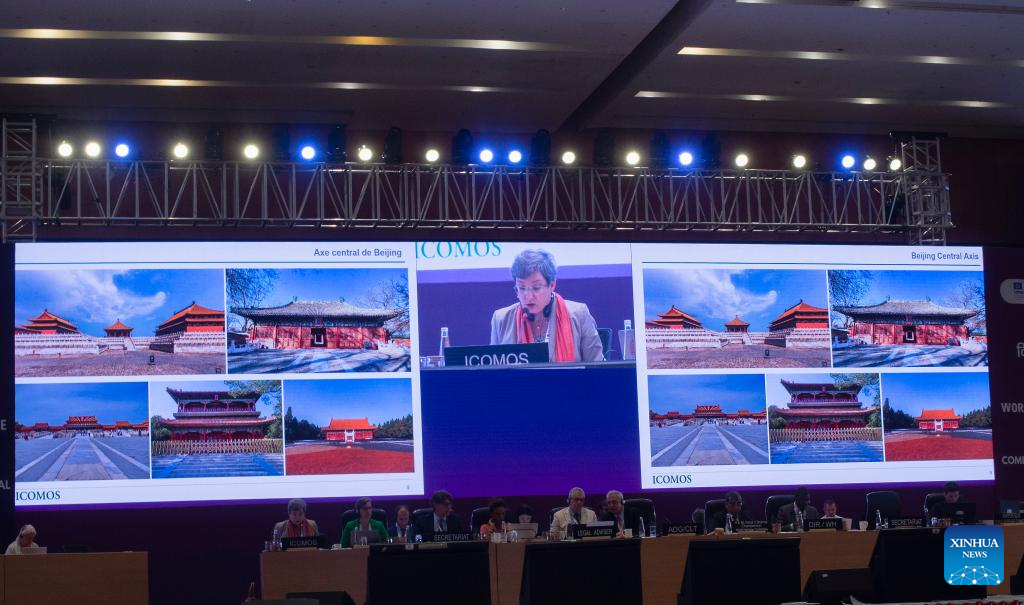
Photos of Beijing Central Axis are displayed on a screen upon its inscription on the World Heritage List by the United Nations Educational, Scientific and Cultural Organization (UNESCO) during the 46th session of the UNESCO World Heritage Committee held in New Delhi, India, July 27, 2024. UNESCO on Saturday announced the inclusion of the Beijing Central Axis: A Building Ensemble Exhibiting the Ideal Order of the Chinese Capital, into its world heritage list. (Xinhua/Javed Dar)

A delegate greets members of the Chinese delegation after the inscription of the Beijing Central Axis on the World Heritage List by the United Nations Educational, Scientific and Cultural Organization (UNESCO) during the 46th session of the UNESCO World Heritage Committee held in New Delhi, India, July 27, 2024. UNESCO on Saturday announced the inclusion of the Beijing Central Axis: A Building Ensemble Exhibiting the Ideal Order of the Chinese Capital, into its world heritage list. (Xinhua/Javed Dar)

Members of the Chinese delegation celebrate the inscription of the Beijing Central Axis on the World Heritage List by the United Nations Educational, Scientific and Cultural Organization (UNESCO) during the 46th session of the UNESCO World Heritage Committee held in New Delhi, India, July 27, 2024. UNESCO on Saturday announced the inclusion of the Beijing Central Axis: A Building Ensemble Exhibiting the Ideal Order of the Chinese Capital, into its world heritage list. (Xinhua/Javed Dar)

Photos of Beijing Central Axis are displayed on a screen upon its inscription on the World Heritage List by the United Nations Educational, Scientific and Cultural Organization (UNESCO) during the 46th session of the UNESCO World Heritage Committee held in New Delhi, India, July 27, 2024. UNESCO on Saturday announced the inclusion of the Beijing Central Axis: A Building Ensemble Exhibiting the Ideal Order of the Chinese Capital, into its world heritage list. (Xinhua/Javed Dar)
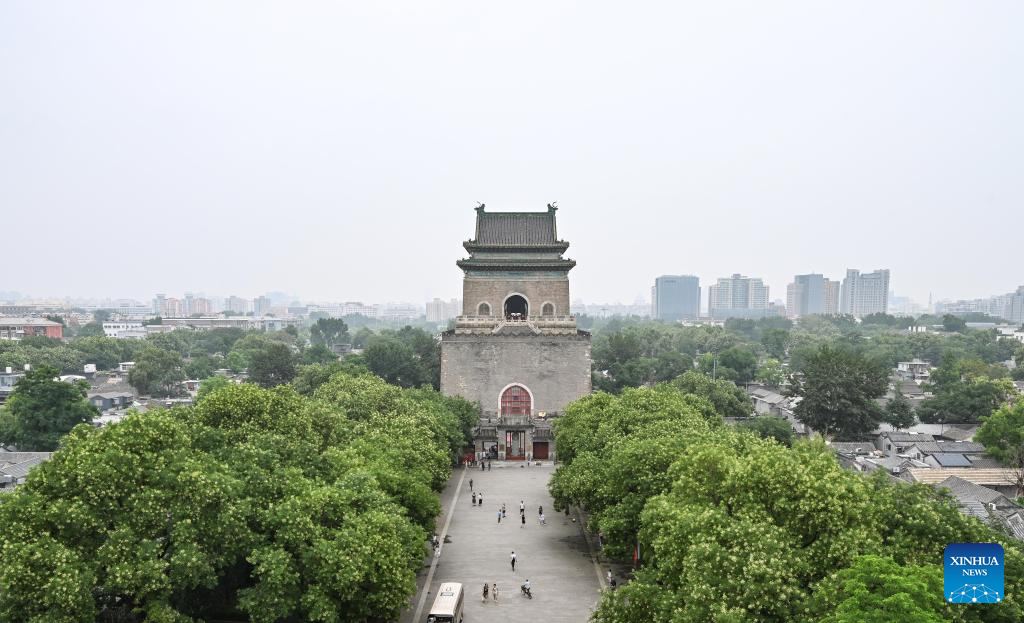
The Bell Tower is pictured in Beijing, capital of China, on July 16, 2024. (Xinhua/Chen Yehua)
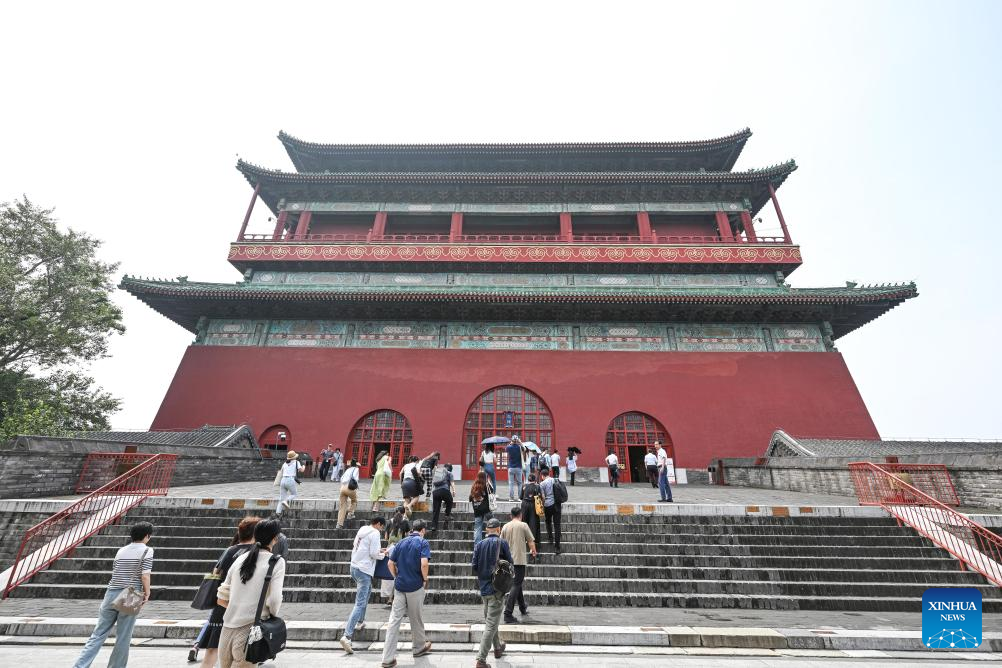
Visitors are pictured in front of the Drum Tower in Beijing, capital of China, July 16, 2024. (Xinhua/Chen Yehua)

A section of ancient pavement (R) is pictured at the Yongdingmen Park in Beijing, capital of China, on July 18, 2024. (Xinhua/Ju Huanzong)

This photo taken on July 16, 2024 shows a view of the Imperial Ancestral Temple in Beijing, capital of China. (Xinhua/Chen Yehua)

People visit the Wanchun pavilion on the mountain top of the Jingshan park in Beijing, capital of China, July 16, 2024. (Xinhua/Chen Yehua)
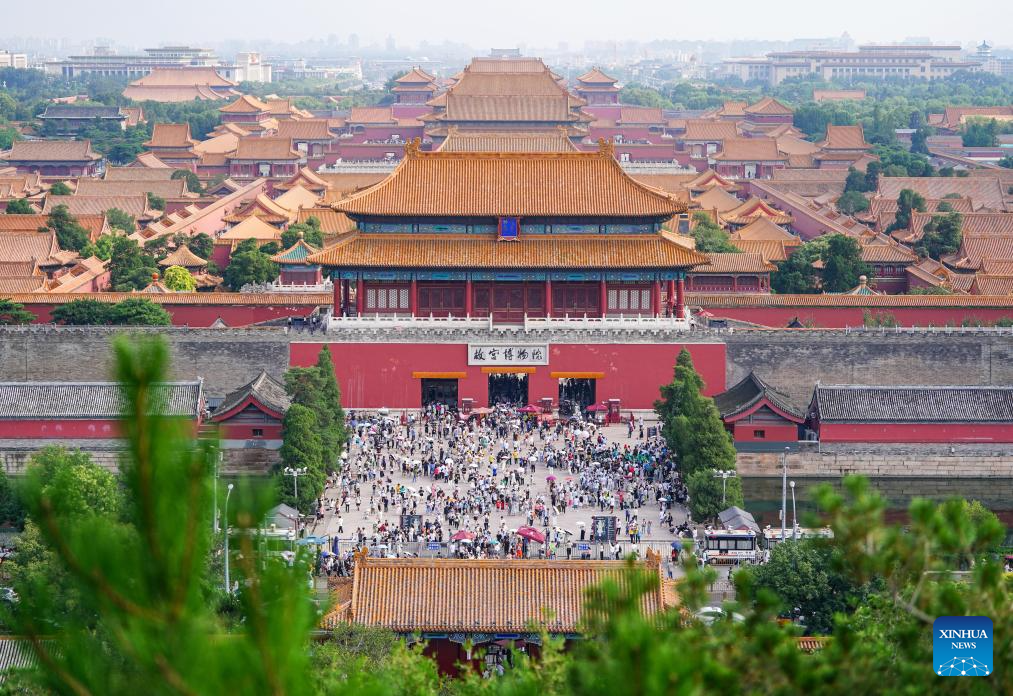
This photo taken on July 16, 2024 shows a view of the Forbidden City in Beijing, capital of China. (Xinhua/Chen Yehua)
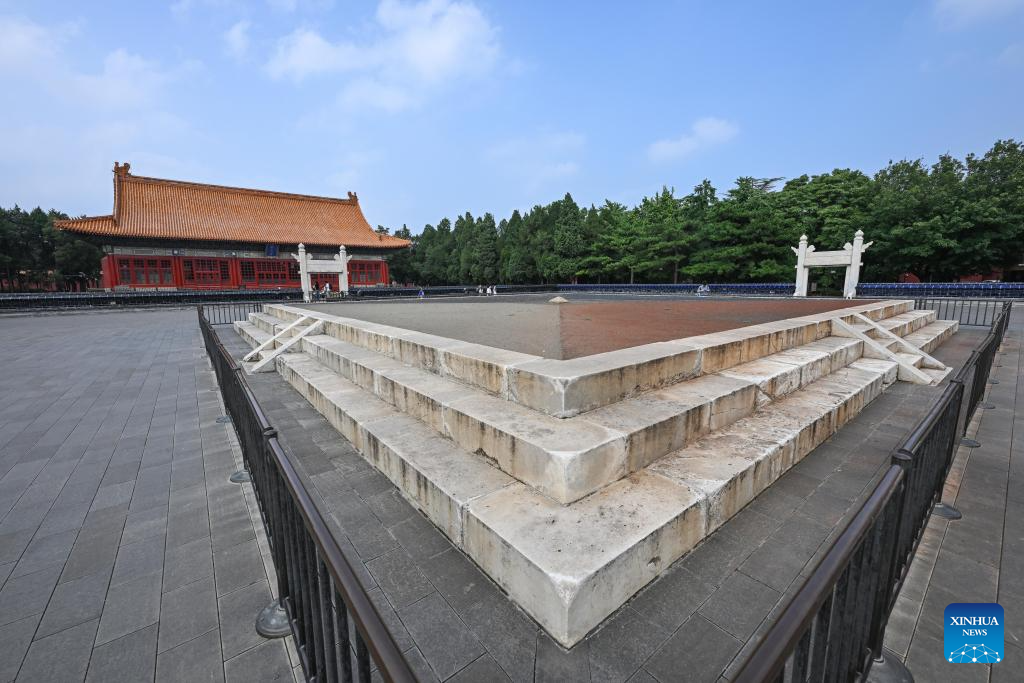
This photo taken on July 16, 2024 shows a view of the Altar of Land and Grain in Beijing, capital of China. (Xinhua/Chen Yehua)
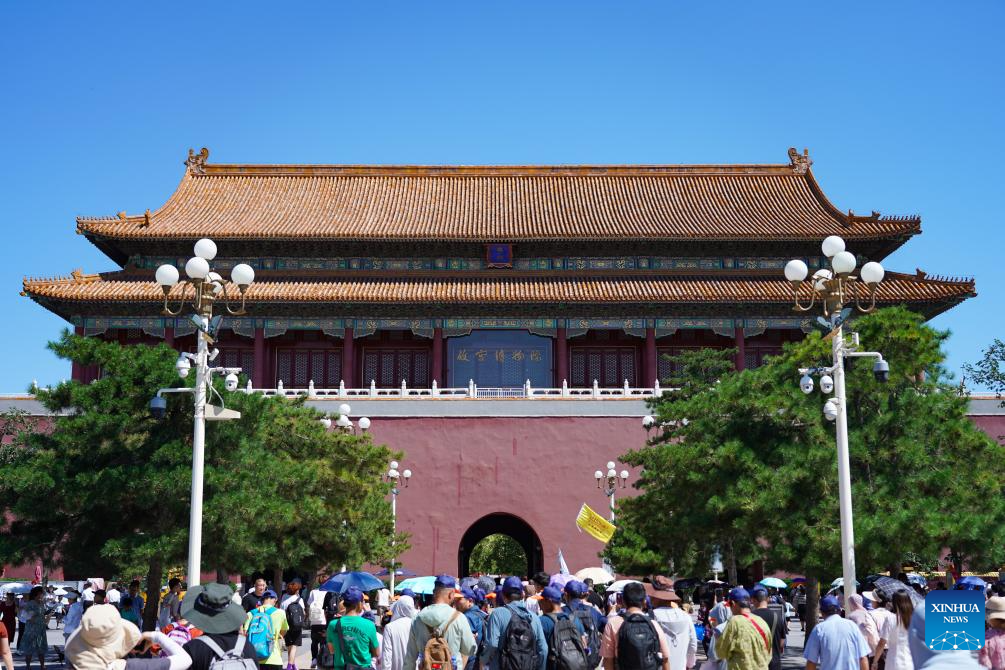
This photo taken on July 17, 2024 shows the Duanmen Gate, or the north entrance to the Forbidden City in Beijing, capital of China. (Xinhua/Chen Zhonghao)

The Tian'anmen Rostrum and the Golden Water River Bridge are pictured in Beijing, capital of China, on July 17, 2024. (Xinhua/Chen Zhonghao)
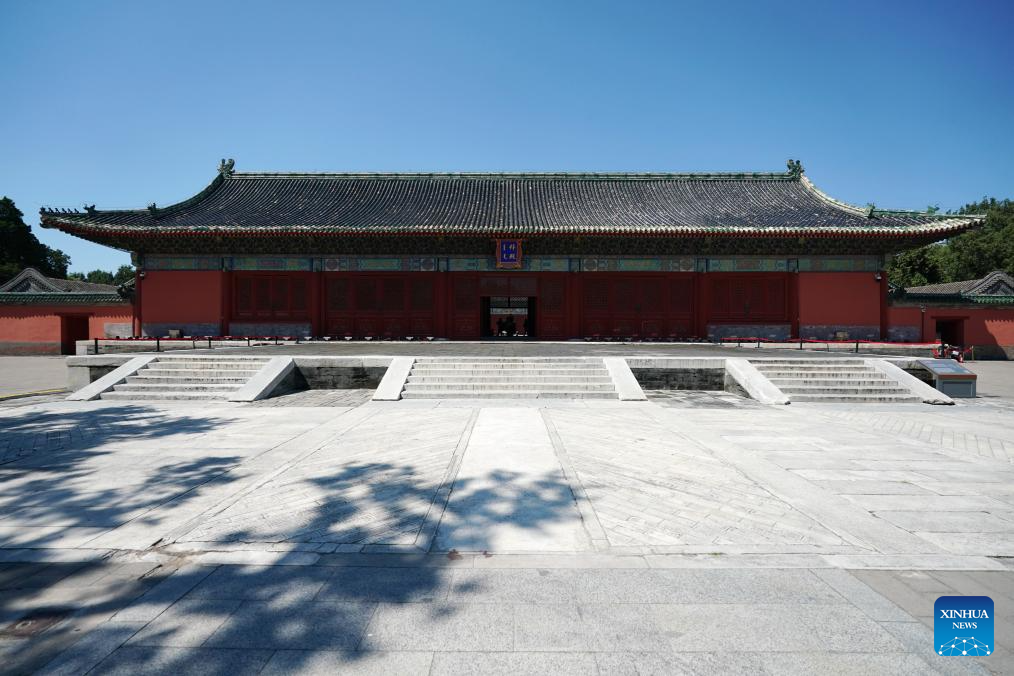
The worship hall of the Temple of Agriculture is pictured in Beijing, capital of China, on July 17, 2024. (Xinhua/Zhang Chenlin)
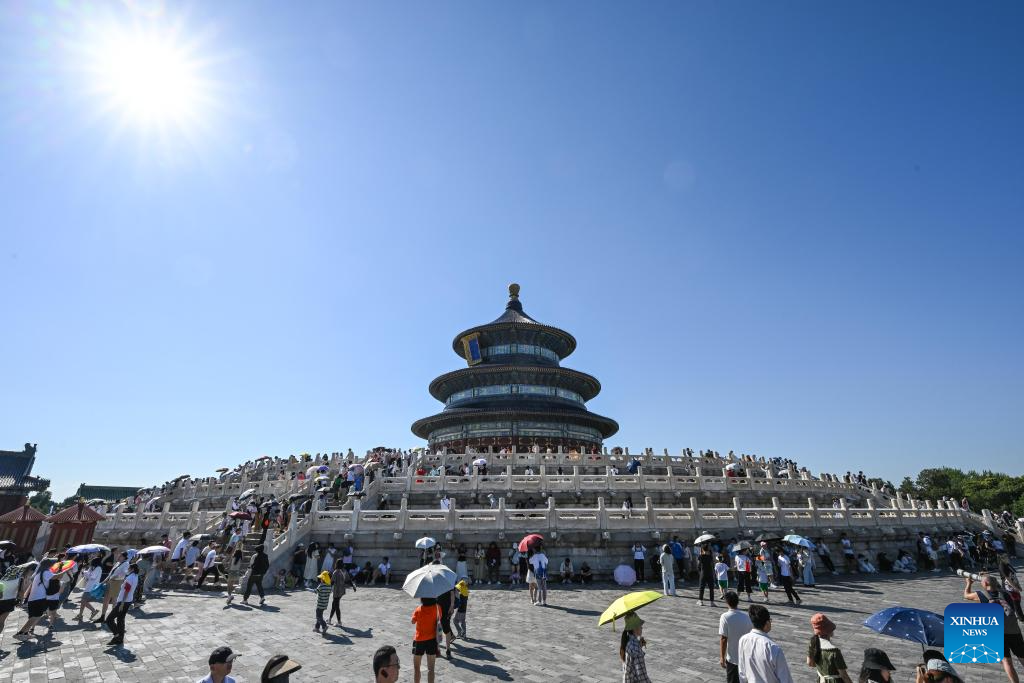
The Hall of Prayer for Good Harvests, or Qiniandian, is pictured at the Tiantan (Temple of Heaven) Park in Beijing, capital of China, July 17, 2024. (Xinhua/Chen Yehua)
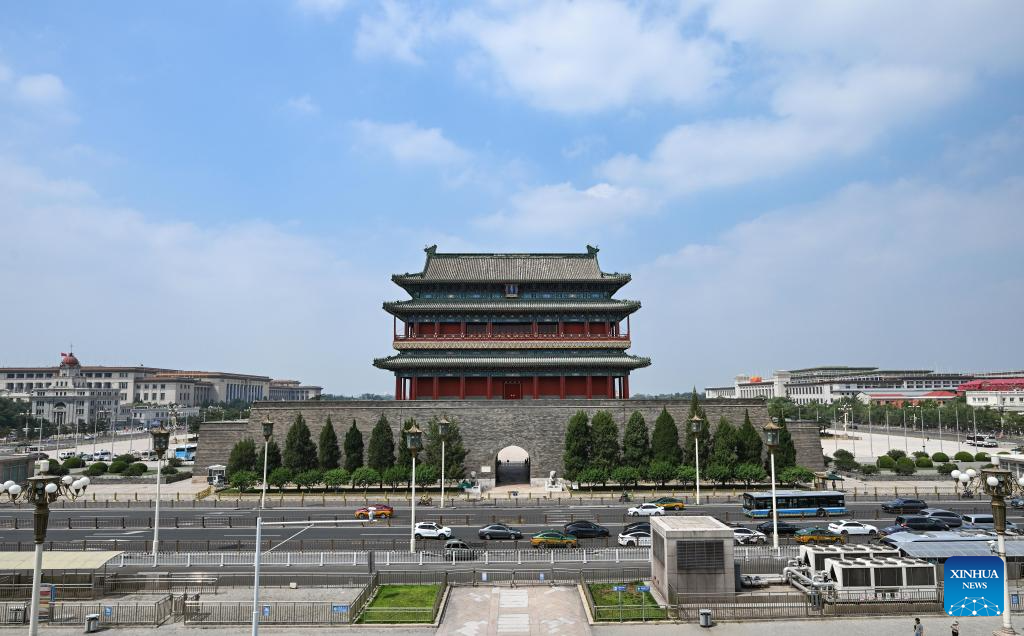
The Zhengyang Gate is pictured from its arrow tower in Beijing, capital of China, July 21, 2024. (Xinhua/Chen Yehua)

The Tian'anmen Square and its surrounding buildings are pictured in Beijing, capital of China, on July 17, 2024. (Xinhua/Chen Zhonghao)
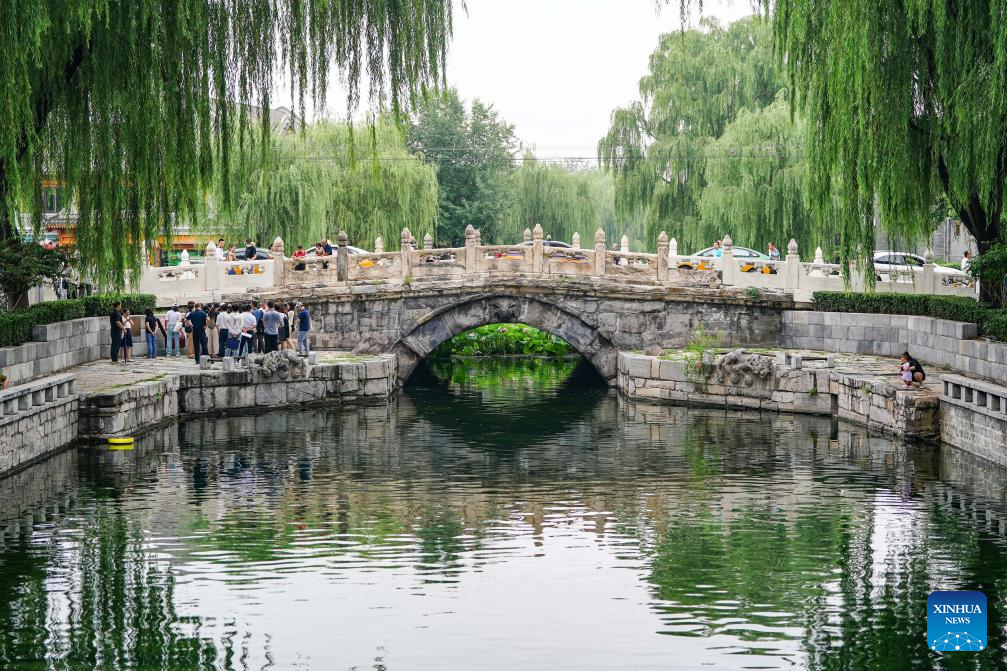
People visit the Wanning Bridge in Beijing, capital of China, July 16, 2024. (Xinhua/Chen Yehua)
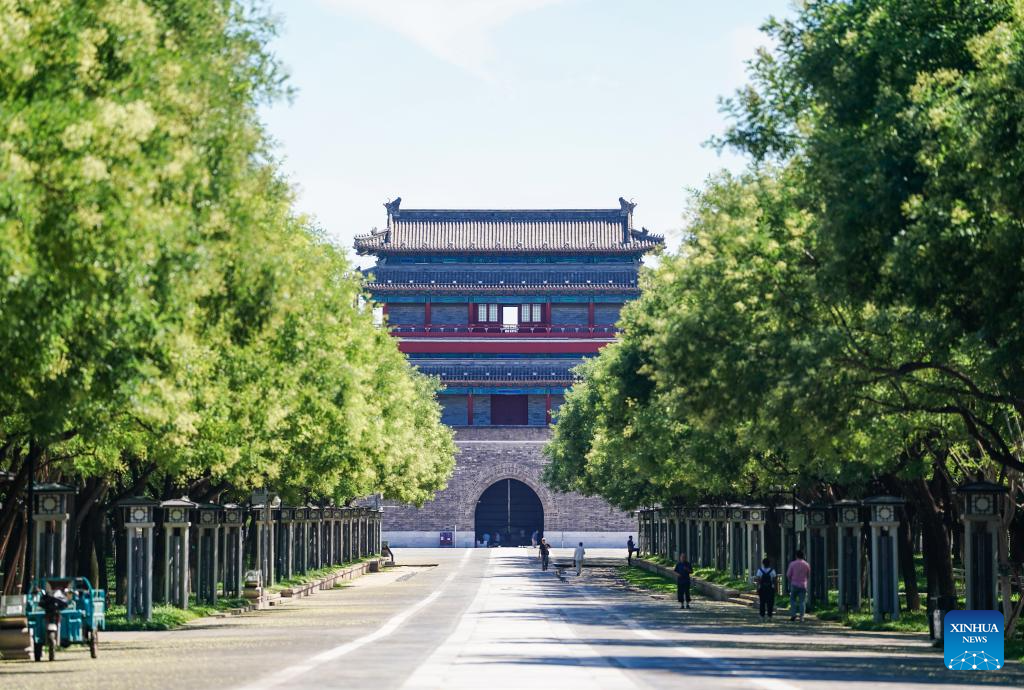
The Yongding Gate is pictured in Beijing, capital of China, on July 17, 2024. (Xinhua/Chen Yehua)
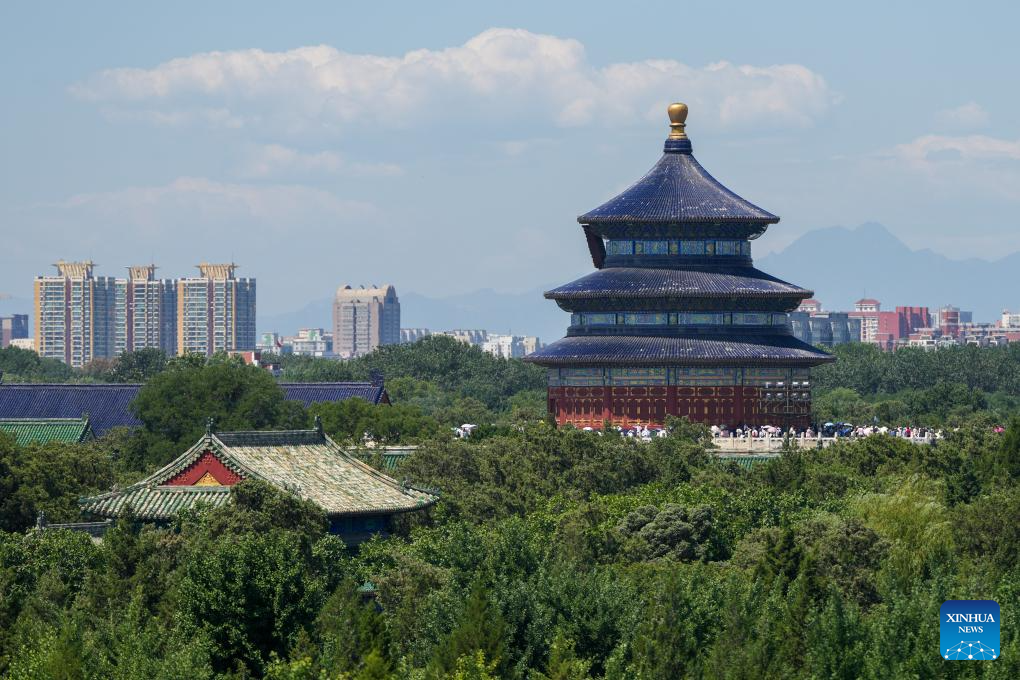
Tourists visit the Temple of Heaven in Beijing, capital of China, June 25, 2024. (Xinhua/Ju Huanzong)
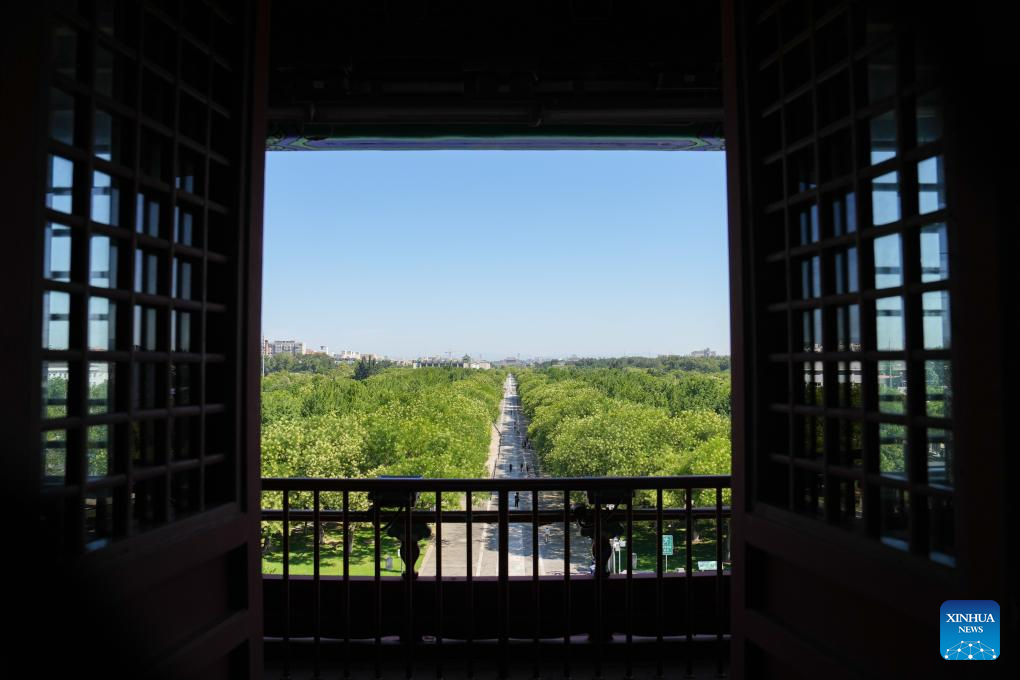
This photo taken from Yongdingmen Gate shows a view of the Beijing Central Axis in Beijing, capital of China, on July 18, 2024. (Xinhua/Ju Huanzong)
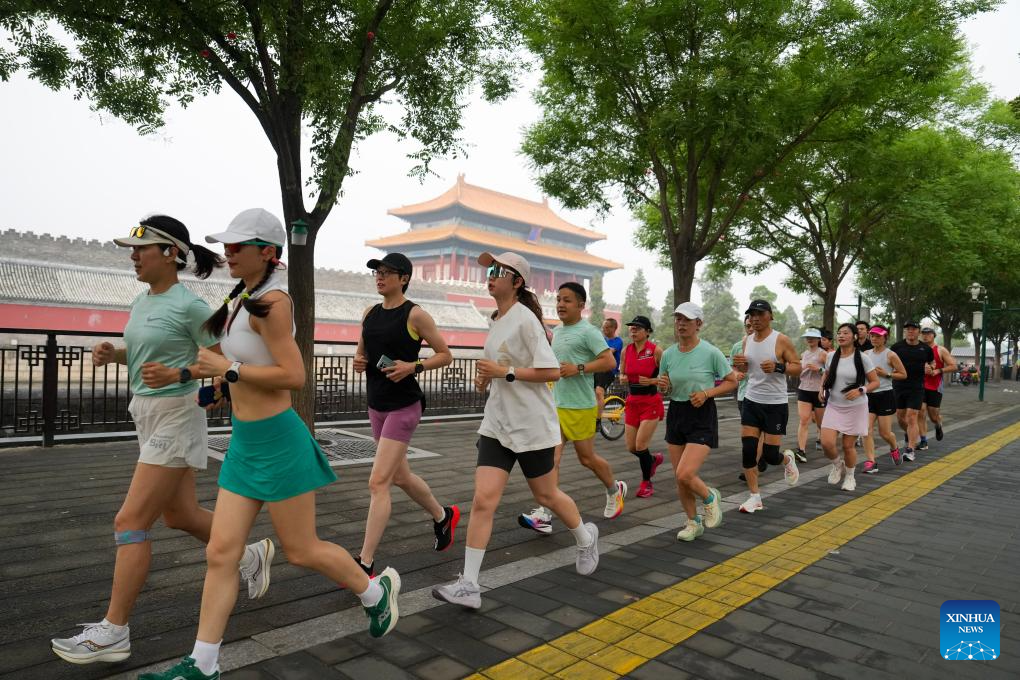
Joggers run past the Shenwu Gate of the Forbidden City in Beijing, capital of China, June 22, 2024. (Xinhua/Ju Huanzong)
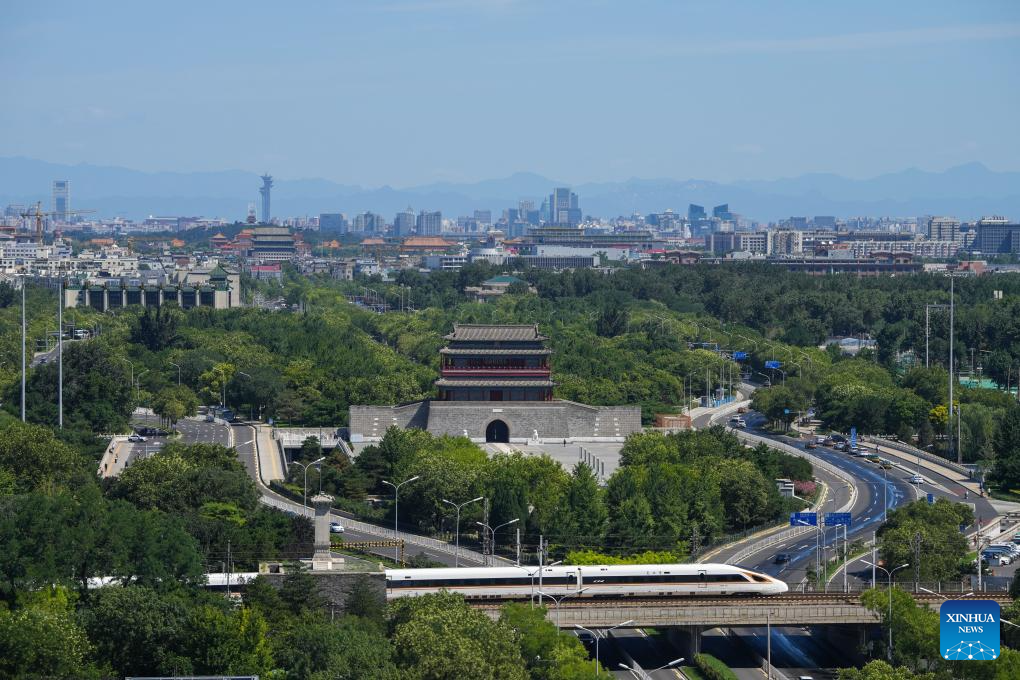
A bullet train runs past Yongdingmen Gate in Beijing, capital of China, July 18, 2024. (Xinhua/Ju Huanzong)
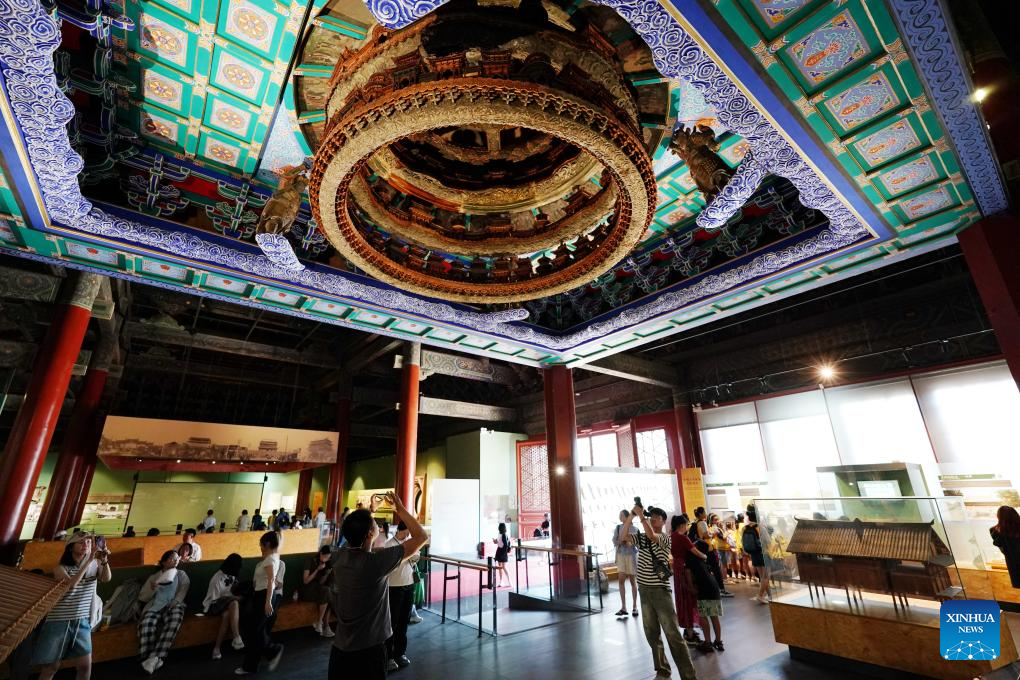
Tourists visit Taisui hall of the Altar of the God of Agriculture in Beijing, capital of China, July 17, 2024. (Xinhua/Zhang Chenlin)
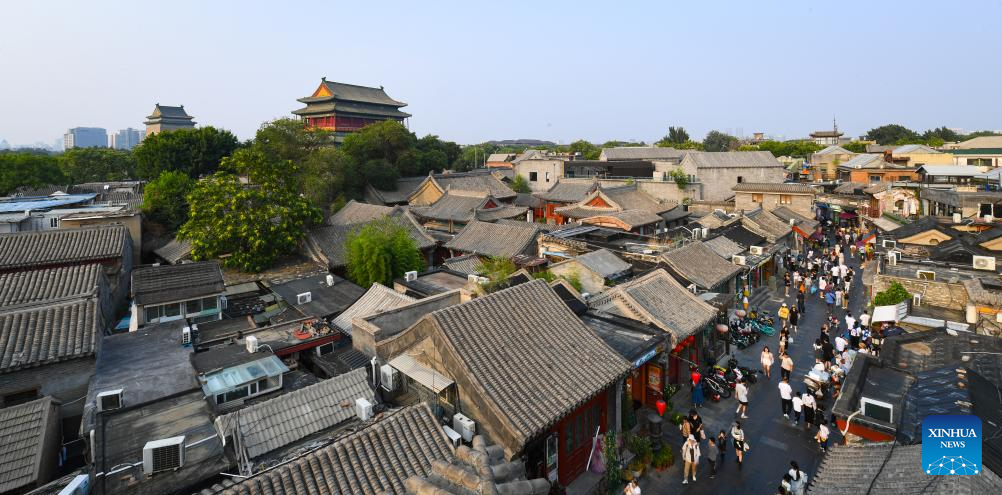
This photo taken on July 10, 2024 shows a view of the Bell and Drum Towers in Beijing, capital of China. (Xinhua/Chen Zhonghao)
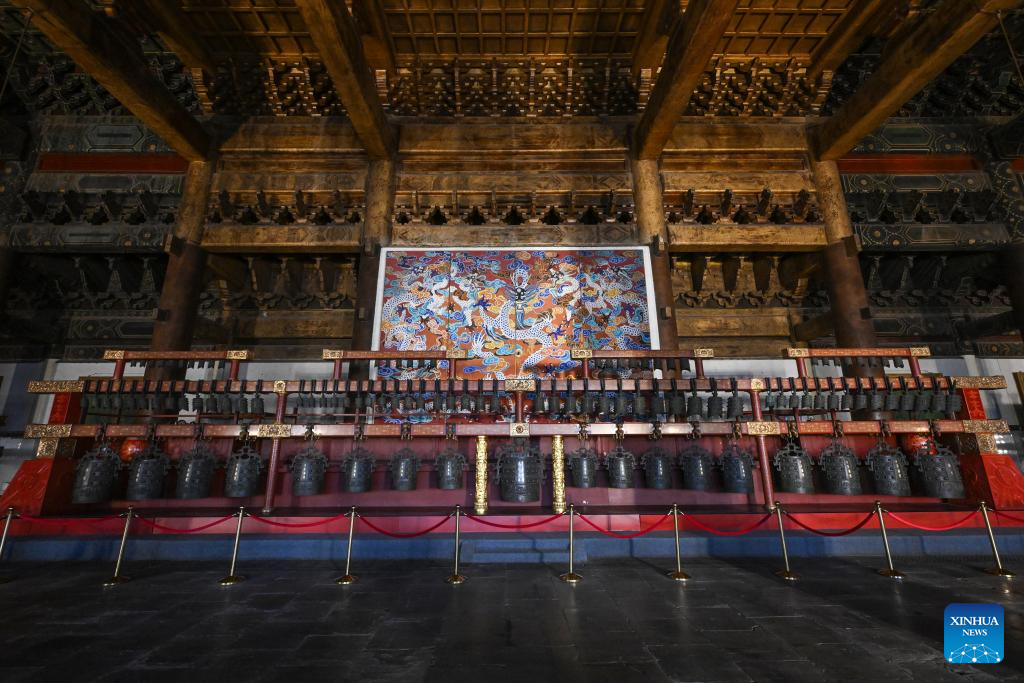
This photo taken on July 16, 2024 shows an interior view of the front hall of the Imperial Ancestral Temple in Beijing, capital of China. (Xinhua/Chen Yehua)

This photo taken on July 17, 2024 shows a view of the Taisui hall of the Altar of the God of Agriculture in Beijing, capital of China. (Xinhua/Zhang Chenlin)

This photo taken on May 31, 2024 shows the Chairman Mao Memorial Hall, Zhengyangmen Gate and Zhengyangmen arrow tower (L to R) in Beijing, capital of China. (Xinhua/Chen Yehua)
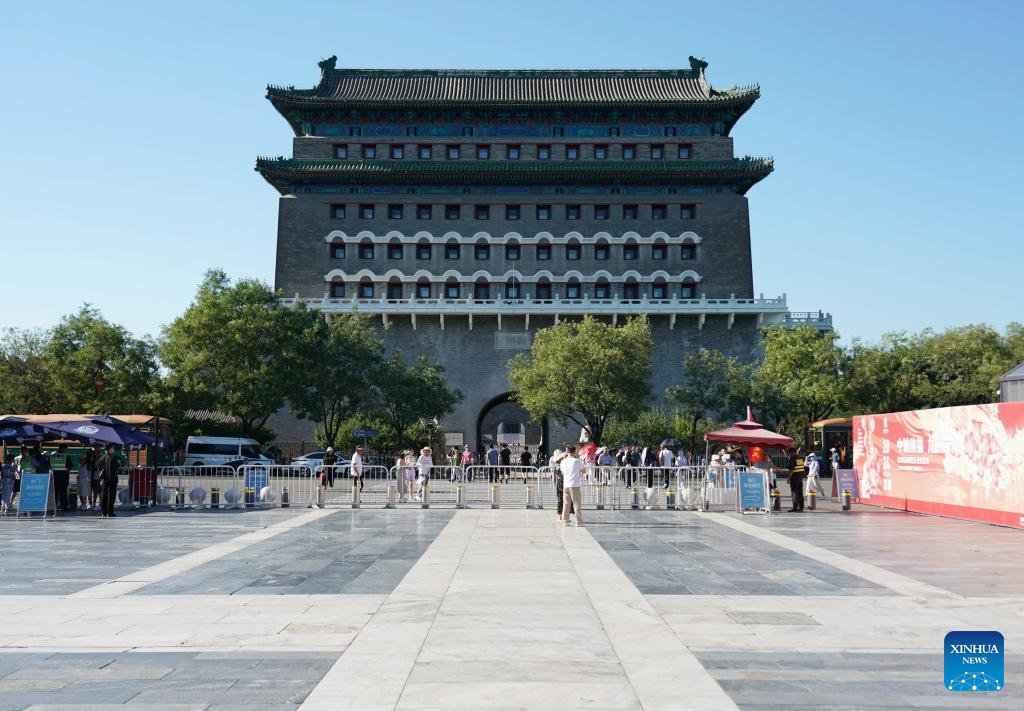
This photo taken on July 17, 2024 shows a view of the Zhengyangmen Gate arrow tower in Beijing, capital of China. (Xinhua/Zhang Chenlin)
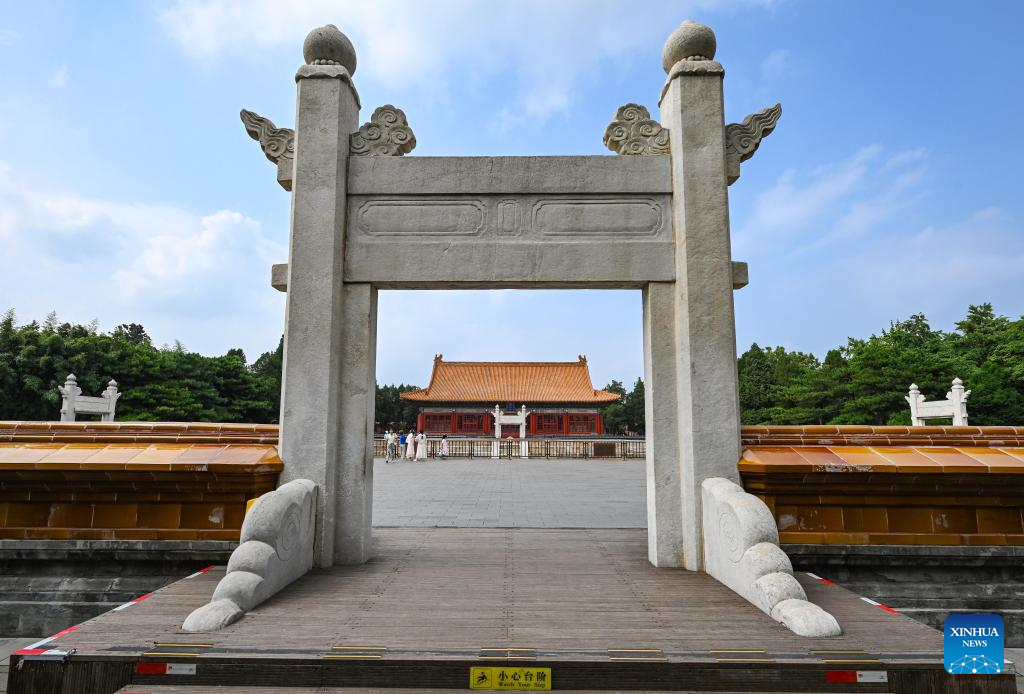
This photo taken on July 16, 2024 shows a view of the Altar of Land and Grain in Beijing, capital of China. (Xinhua/Chen Yehua)

This photo taken on May 31, 2024 shows a view of the Forbidden City in Beijing, capital of China. (Xinhua/Chen Yehua)

Citizens enjoy leisure time at Yongdingmen Park in Beijing, capital of China, July 17, 2024. (Xinhua/Chen Zhonghao)
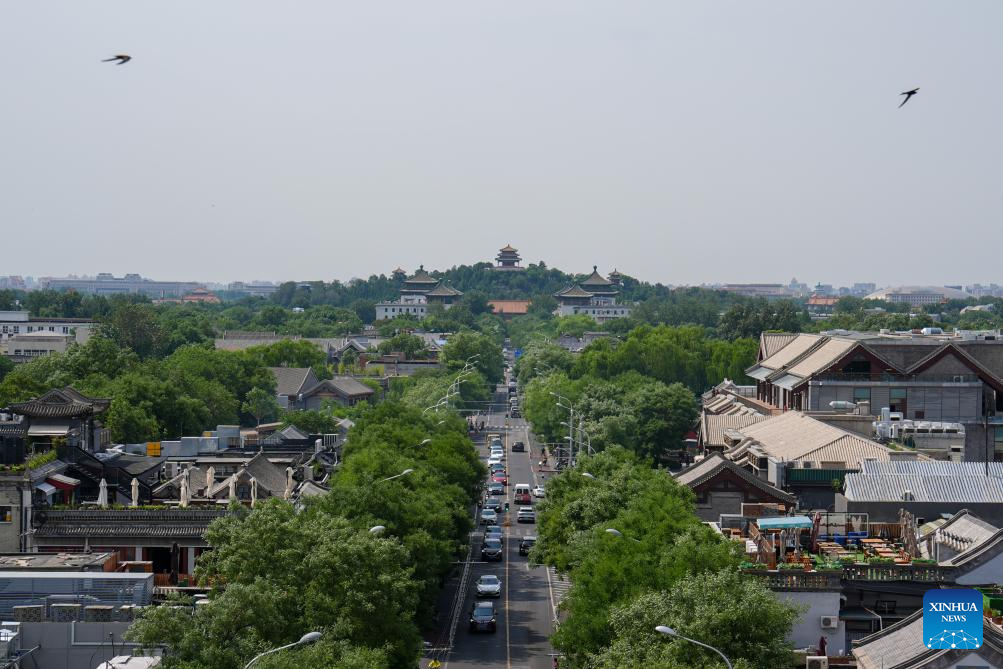
This photo taken from the Drum Tower shows a view of the Beijing Central Axis in Beijing, capital of China, June 2, 2024. (Xinhua/Ju Huanzong)
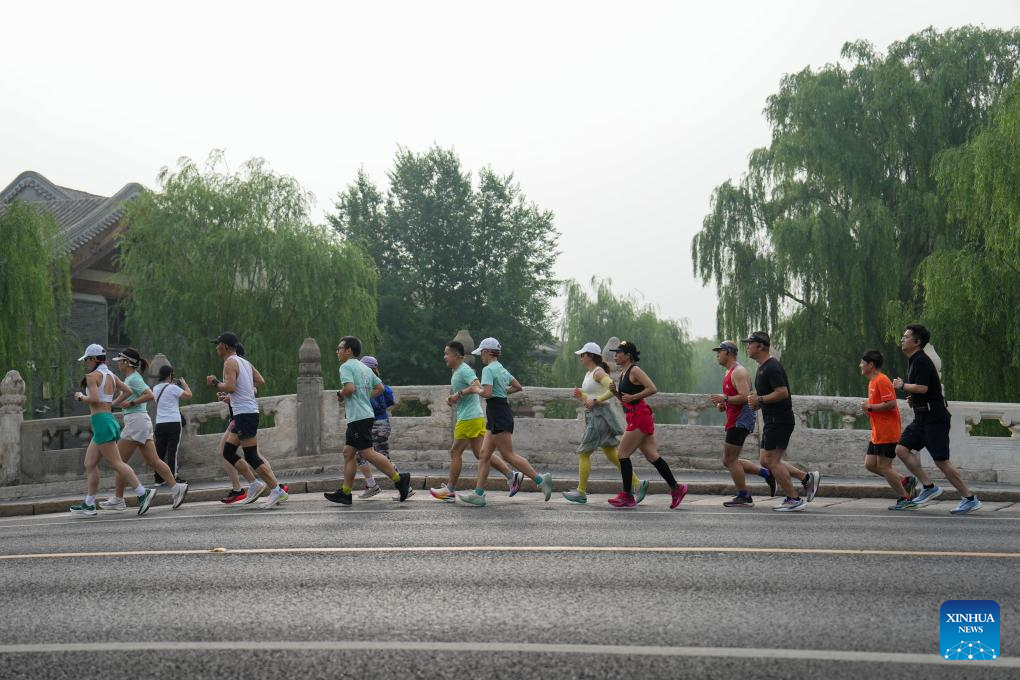
Joggers run on the Wanning Bridge in Beijing, capital of China, June 22, 2024. (Xinhua/Ju Huanzong)
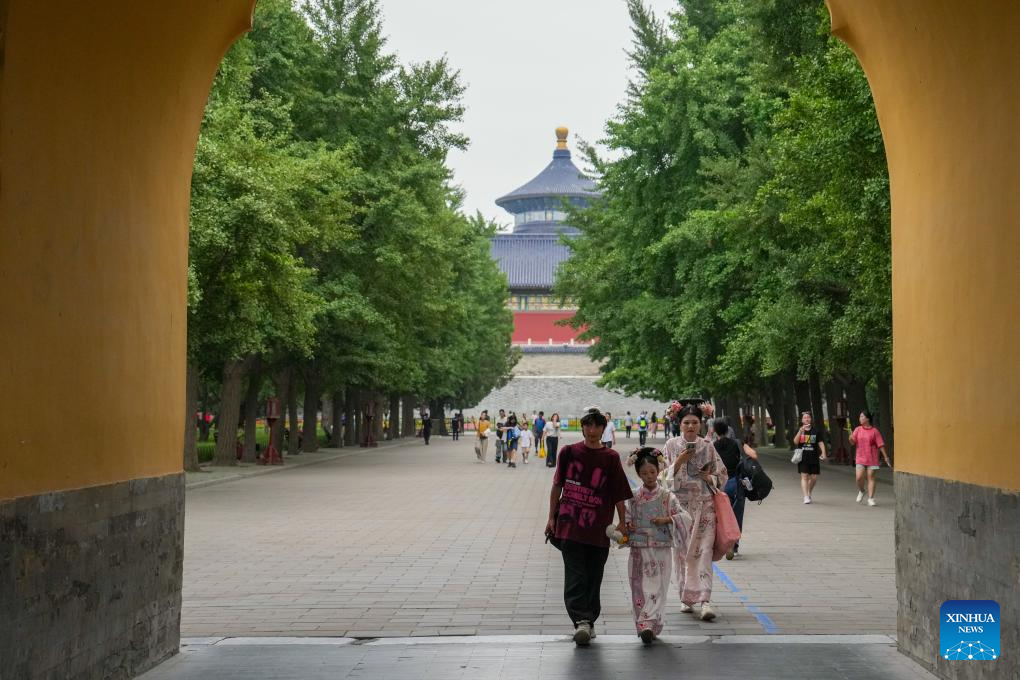
Tourists visit the Temple of Heaven in Beijing, capital of China, July 19, 2024. (Xinhua/Ju Huanzong)

This photo taken on July 16, 2024 shows a view of the Altar of Land and Grain in Beijing, capital of China. (Xinhua/Chen Zhonghao)
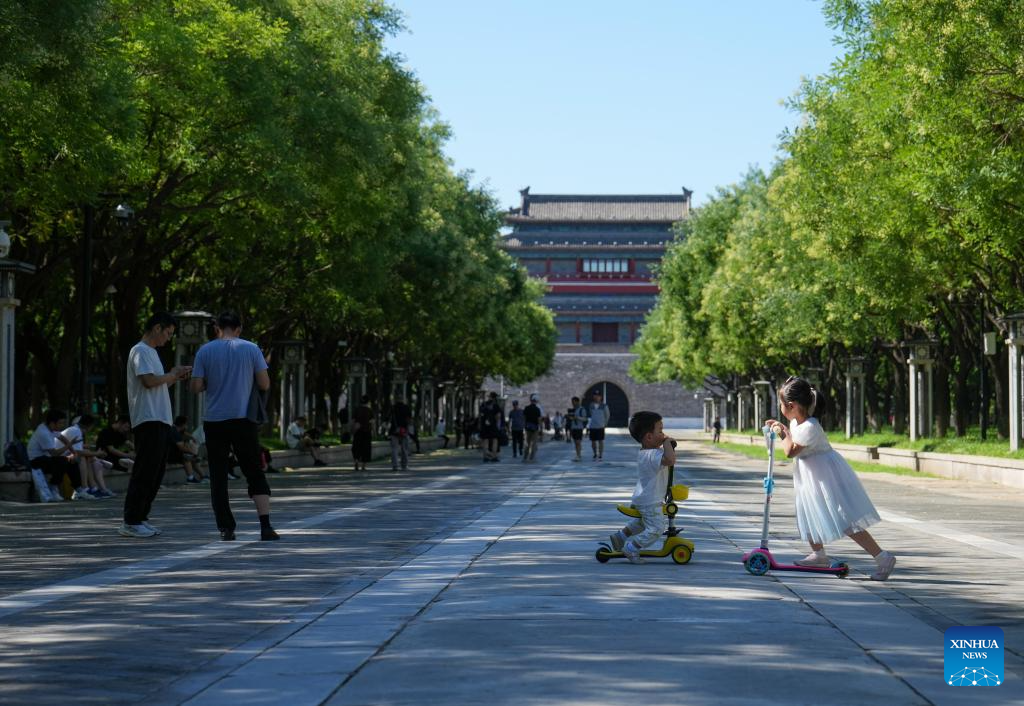
Tourists visit Yongdingmen Park in Beijing, capital of China, July 18, 2024. (Xinhua/Ju Huanzong)
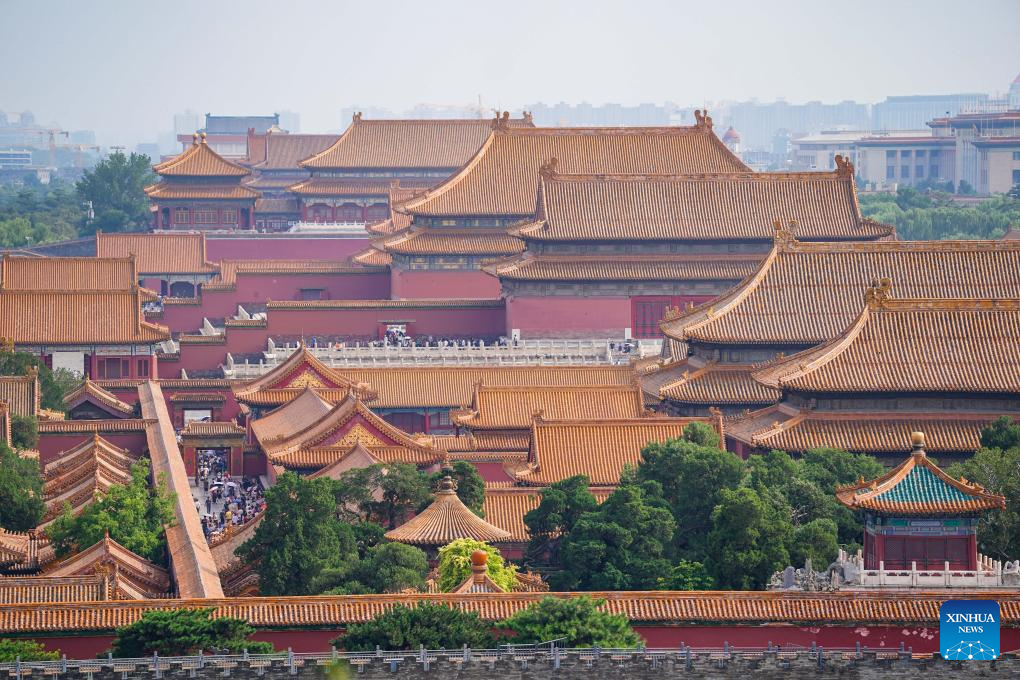
This photo taken on July 16, 2024 shows a view of the Forbidden City seen from the Jingshan Park in Beijing, capital of China. (Xinhua/Chen Yehua)

This photo taken on July 16, 2024 shows a view of the Wanning Bridge in Beijing, capital of China. (Xinhua/Chen Yehua)
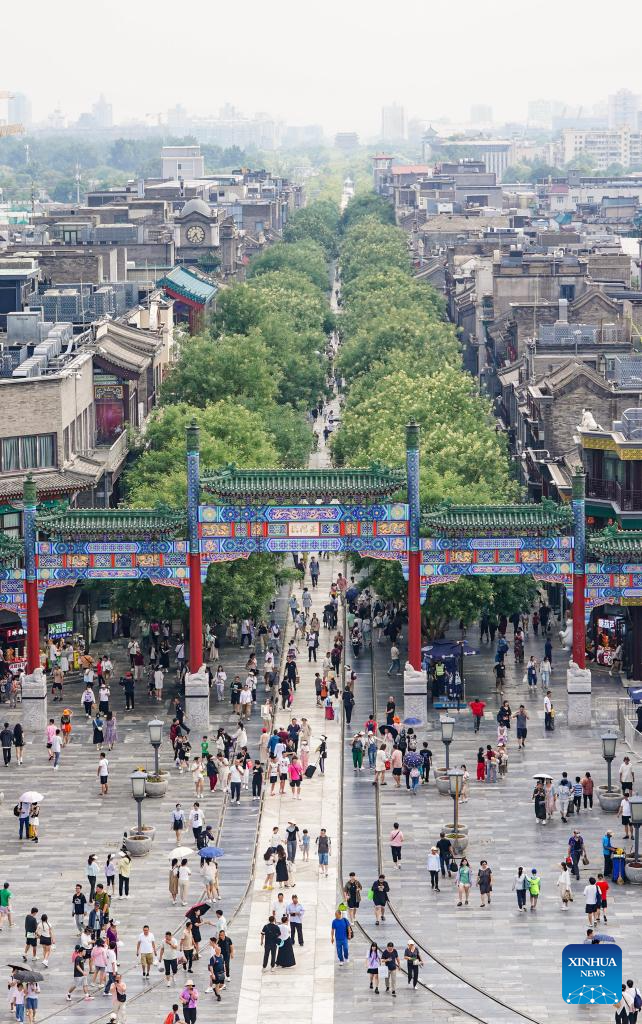
This photo taken on July 21, 2024 shows Qianmen Street and Yongdingmen Gate in the distance seen from the Zhengyangmen Gate arrow tower in Beijing, capital of China. (Xinhua/Chen Yehua)
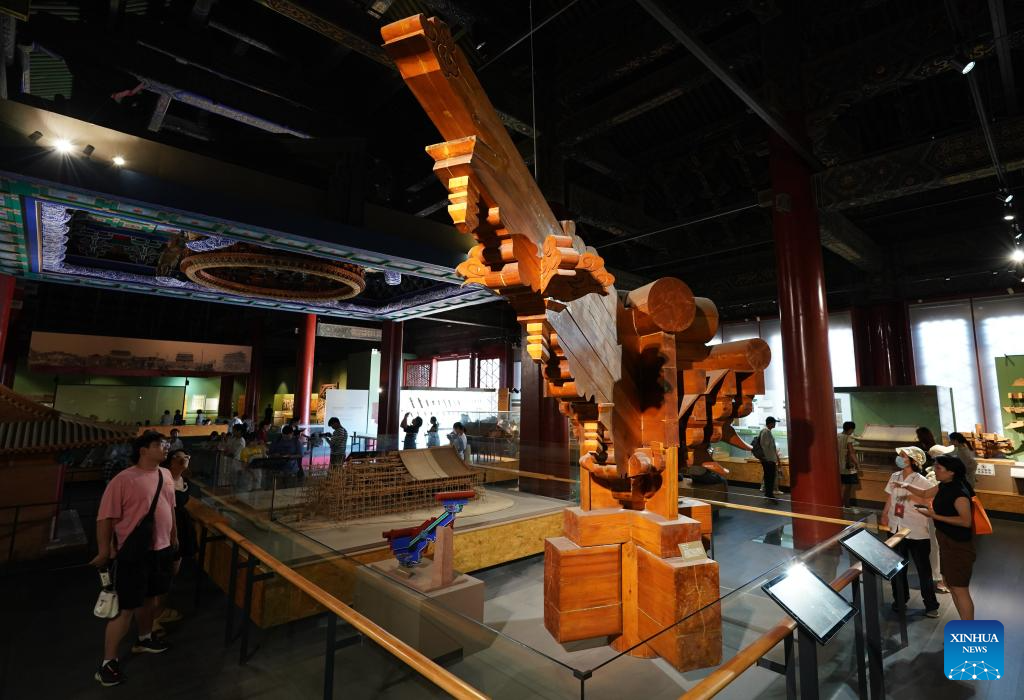
Tourists visit Taisui hall of the Altar of the God of Agriculture in Beijing, capital of China, July 17, 2024. (Xinhua/Zhang Chenlin)
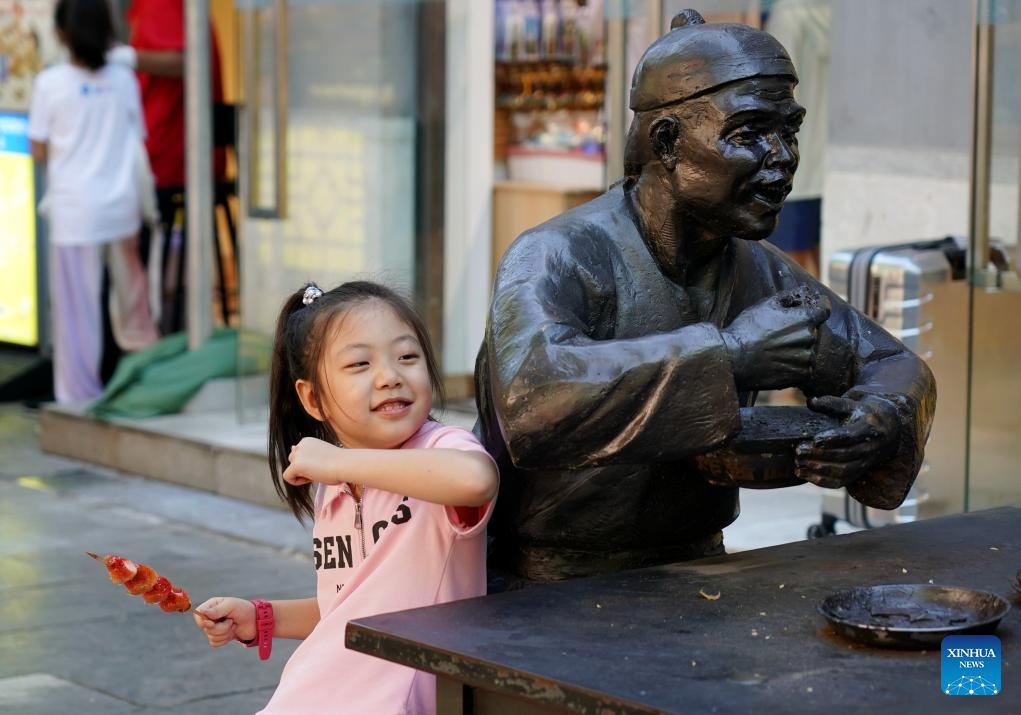
A girl is pictured near an urban sculpture at Qianmen Street in Beijing, capital of China, July 17, 2024. (Xinhua/Zhang Chenlin)
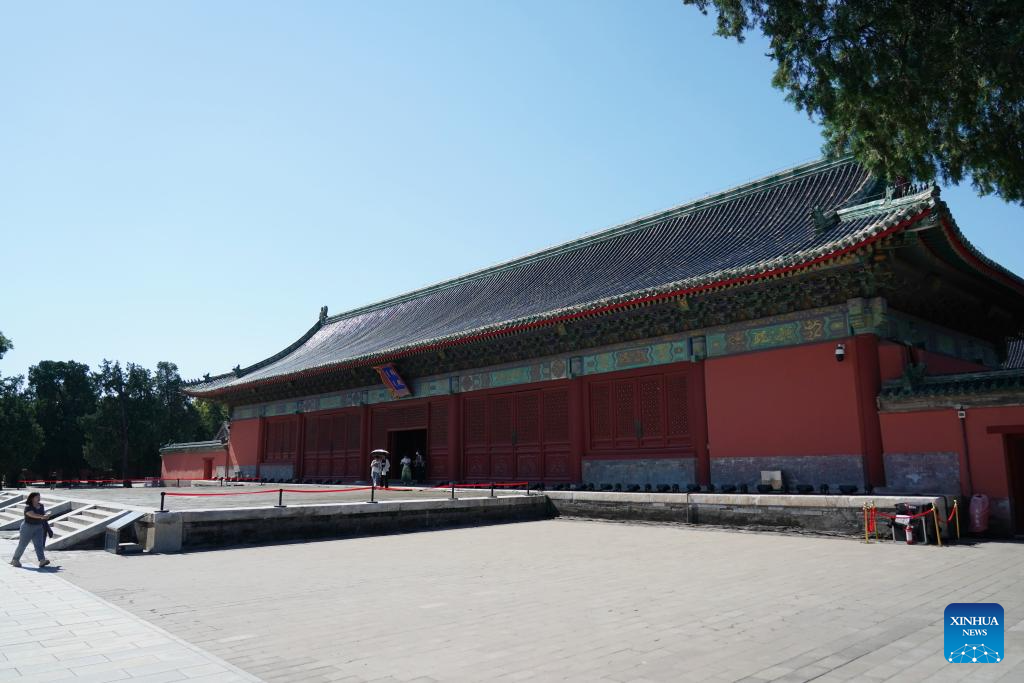
This photo taken on July 17, 2024 shows a view of the worship hall of the Altar of the God of Agriculture in Beijing, capital of China. (Xinhua/Zhang Chenlin)
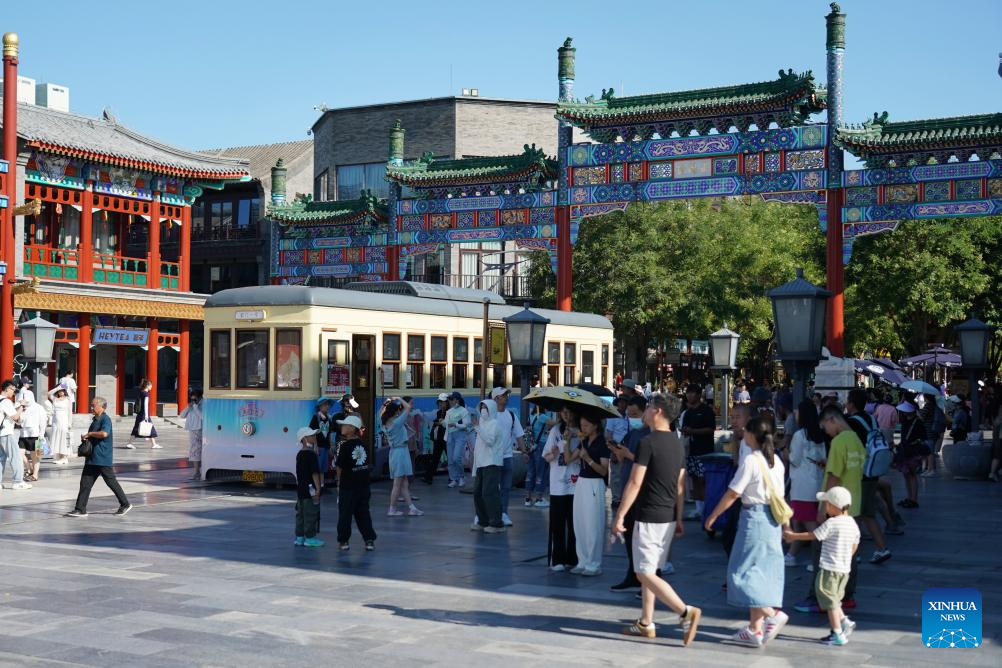
Tourists visit Qianmen Street in Beijing, capital of China, July 17, 2024. (Xinhua/Zhang Chenlin)
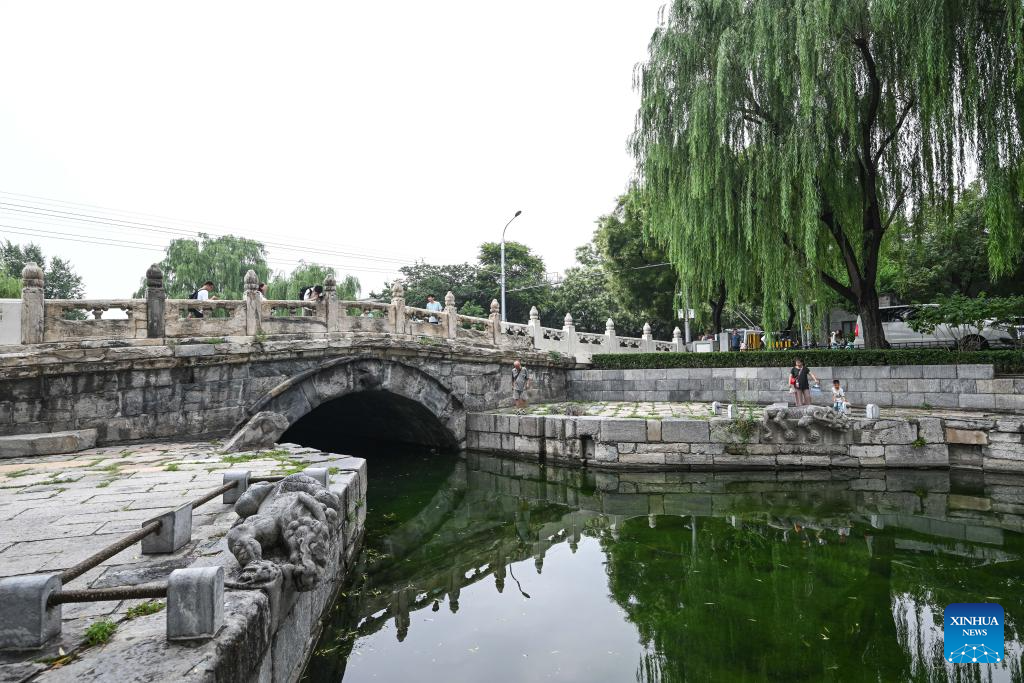
This photo taken on July 16, 2024 shows a view of the Wanning Bridge in Beijing, capital of China. (Xinhua/Chen Yehua)

This photo taken on July 16, 2024 shows a view of the Imperial Ancestral Temple in Beijing, capital of China. (Xinhua/Chen Yehua)

Tourists are seen at the Wumen Gate of the Forbidden City in Beijing, capital of China, July 16, 2024. (Xinhua/Chen Yehua)
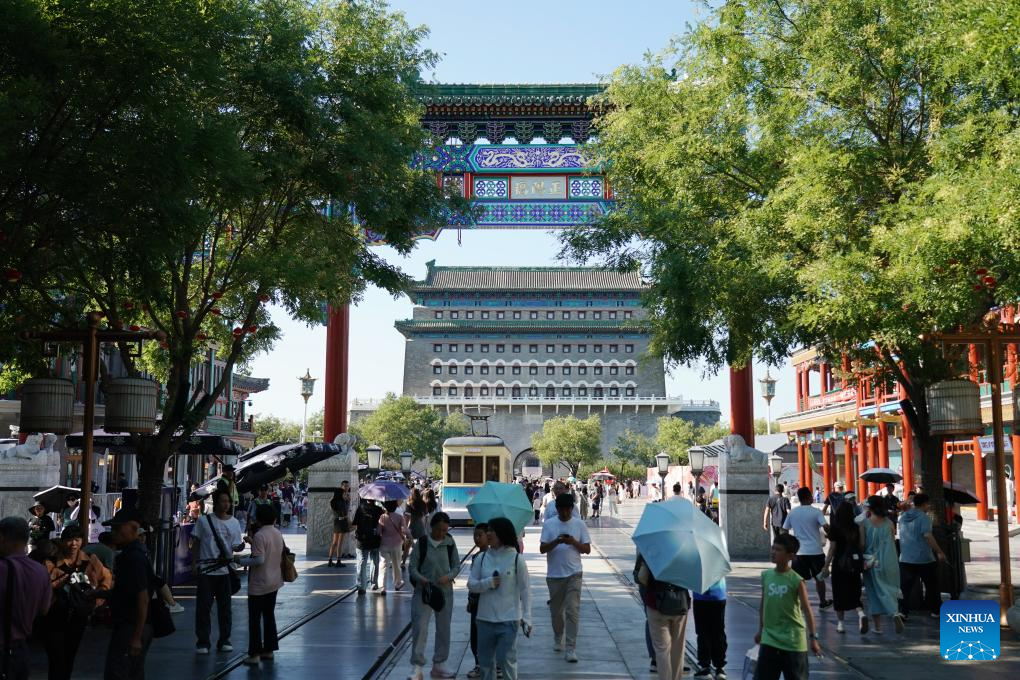
Tourists visit Qianmen Street in Beijing, capital of China, July 17, 2024. (Xinhua/Zhang Chenlin)

This photo taken on July 21, 2024 shows Qianmen Street and Yongdingmen Gate in the distance seen from the Zhengyangmen Gate arrow tower in Beijing, capital of China. (Xinhua/Chen Yehua)
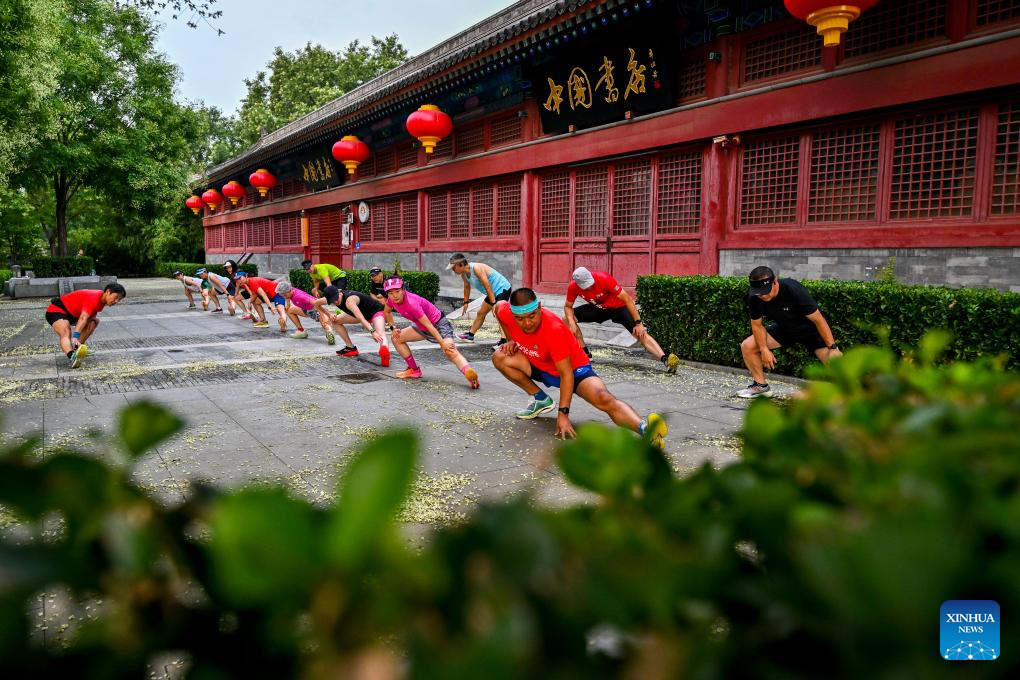
Running enthusiasts warm up in front of a bookstore at Di'anmen Gate in Beijing, capital of China, July 20, 2024. The Beijing Central Axis is a running route full of cultural vibe in the eyes of running enthusiasts. (Xinhua/Liu Jinhai)

Running enthusiasts run past the Drum Tower in Beijing, capital of China, July 20, 2024. The Beijing Central Axis is a running route full of cultural vibe in the eyes of running enthusiasts. (Xinhua/Liu Jinhai)

Running enthusiasts pose for a group photo in front of a turret of the Forbidden City in Beijing, capital of China, July 20, 2024. The Beijing Central Axis is a running route full of cultural vibe in the eyes of running enthusiasts. (Xinhua/Chen Zhonghao)
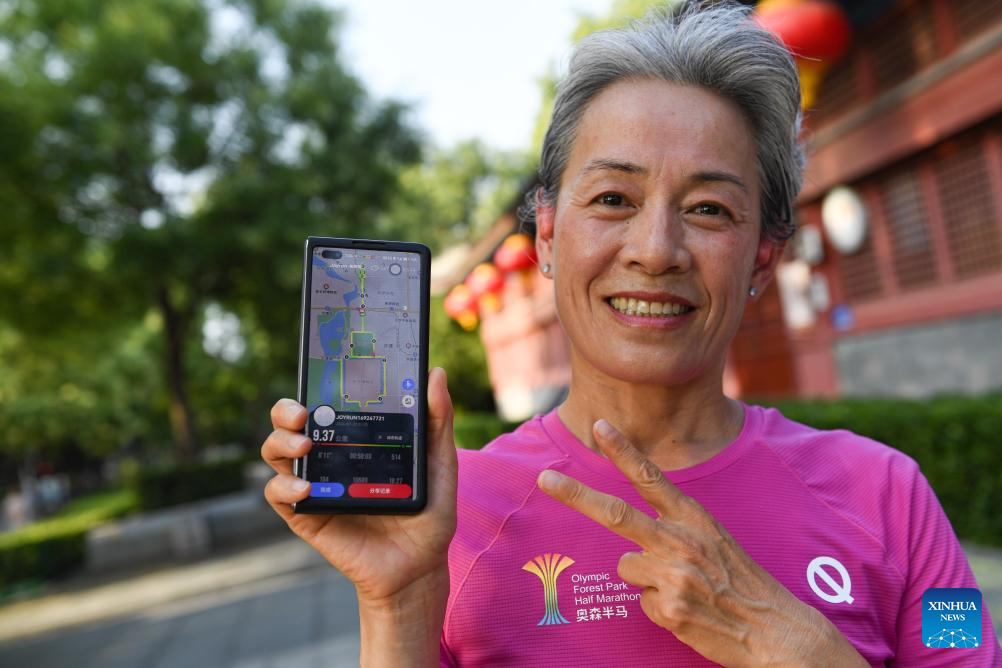
Running enthusiast Liu Jixiang shows her running trace along the Beijing Central Axis in Beijing, capital of China, July 20, 2024. The Beijing Central Axis is a running route full of cultural vibe in the eyes of running enthusiasts. (Xinhua/Chen Zhonghao)
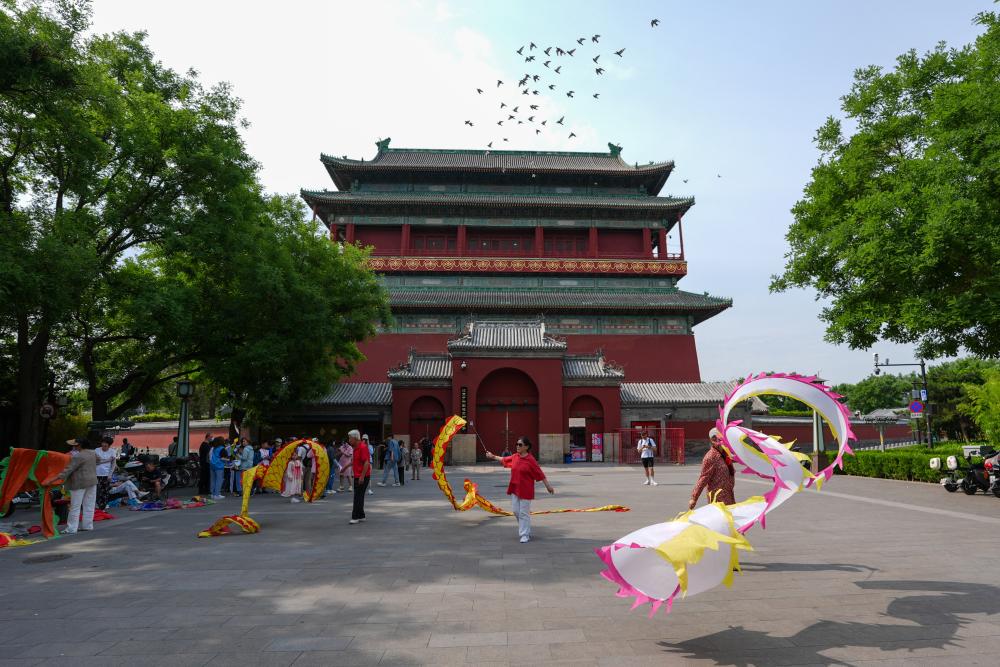
Citizens exercise at a square in front of the Bell and Drum Towers in Beijing, capital of China, June 2, 2024. The United Nations Educational, Scientific and Cultural Organization (UNESCO) on Saturday announced the inclusion of the Beijing Central Axis: A Building Ensemble Exhibiting the Ideal Order of the Chinese Capital, into its world heritage list.
So far, China has a total of 59 World Heritage Sites.
Beijing Central Axis, initially established in the 13th century and formed in the 16th century, runs through the old city of Beijing from north to south. It has become the longest urban axis in the world today, spanning 7.8 kilometers.
The heritage area of the Beijing Central Axis covers 589 hectares, with a buffer zone of 4,542 hectares. Its location, layout, urban form, and design reflect the ancient Chinese tradition of urban planning, serving as an important emblem that highlights the distinctive characteristics of Chinese civilization. (Xinhua/Ju Huanzong)
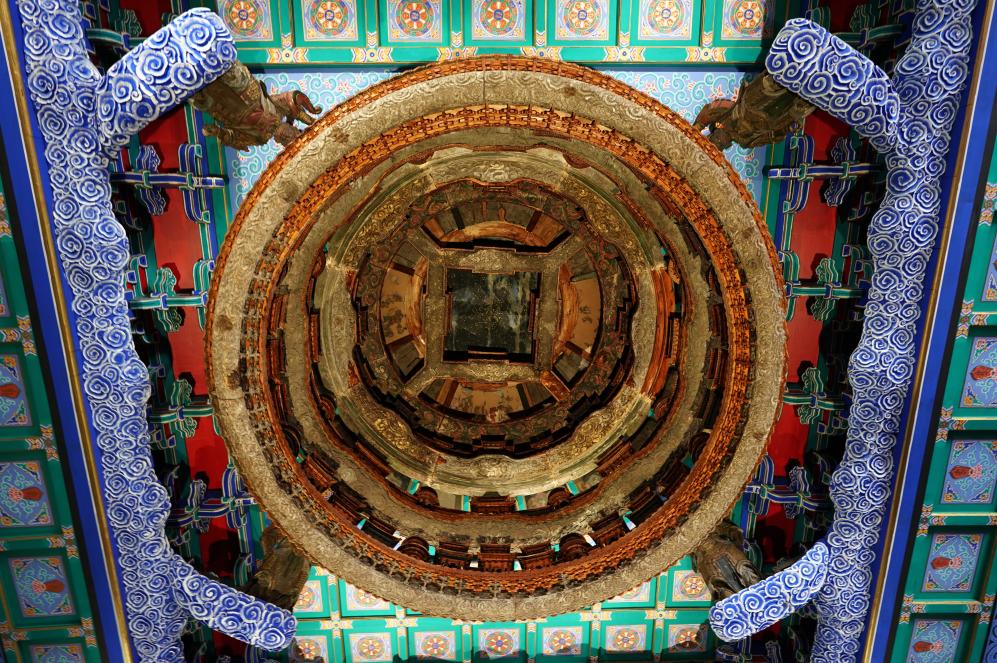
This photo taken on July 17, 2024 shows a caisson ceiling of the Longfu Temple displayed in Taisui hall of the Altar of the God of Agriculture in Beijing, capital of China. The United Nations Educational, Scientific and Cultural Organization (UNESCO) on Saturday announced the inclusion of the Beijing Central Axis: A Building Ensemble Exhibiting the Ideal Order of the Chinese Capital, into its world heritage list.
So far, China has a total of 59 World Heritage Sites.
Beijing Central Axis, initially established in the 13th century and formed in the 16th century, runs through the old city of Beijing from north to south. It has become the longest urban axis in the world today, spanning 7.8 kilometers.
The heritage area of the Beijing Central Axis covers 589 hectares, with a buffer zone of 4,542 hectares. Its location, layout, urban form, and design reflect the ancient Chinese tradition of urban planning, serving as an important emblem that highlights the distinctive characteristics of Chinese civilization. (Xinhua/Zhang Chenlin)
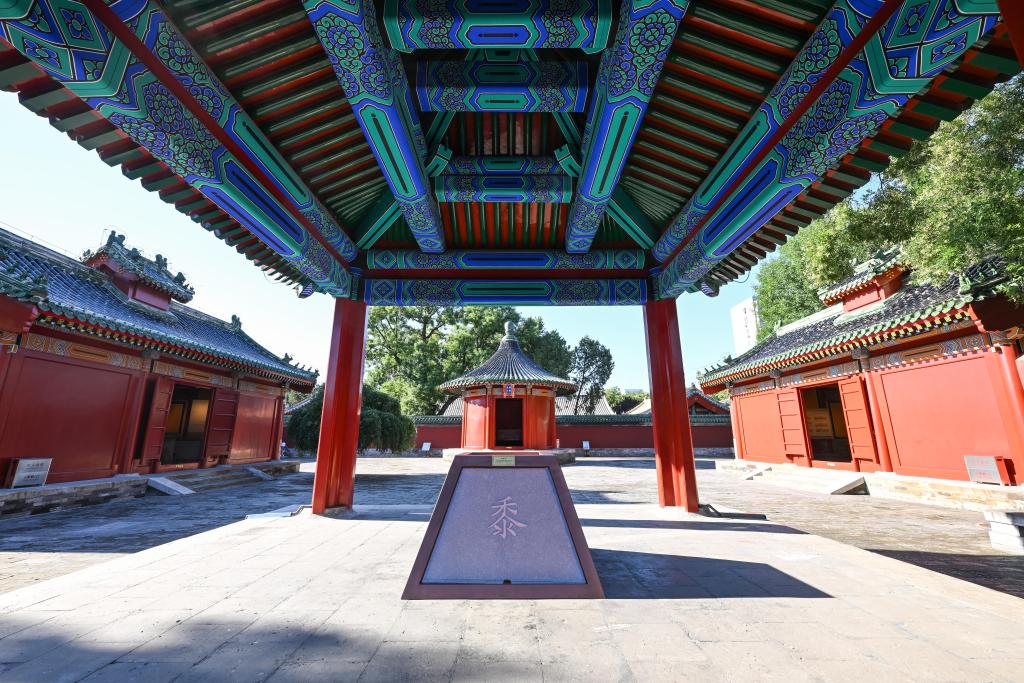
This photo taken on July 17, 2024 shows a view in the Altar of the God of Agriculture in Beijing, capital of China. The United Nations Educational, Scientific and Cultural Organization (UNESCO) on Saturday announced the inclusion of the Beijing Central Axis: A Building Ensemble Exhibiting the Ideal Order of the Chinese Capital, into its world heritage list.
So far, China has a total of 59 World Heritage Sites.
Beijing Central Axis, initially established in the 13th century and formed in the 16th century, runs through the old city of Beijing from north to south. It has become the longest urban axis in the world today, spanning 7.8 kilometers.
The heritage area of the Beijing Central Axis covers 589 hectares, with a buffer zone of 4,542 hectares. Its location, layout, urban form, and design reflect the ancient Chinese tradition of urban planning, serving as an important emblem that highlights the distinctive characteristics of Chinese civilization. (Xinhua/Chen Yehua)
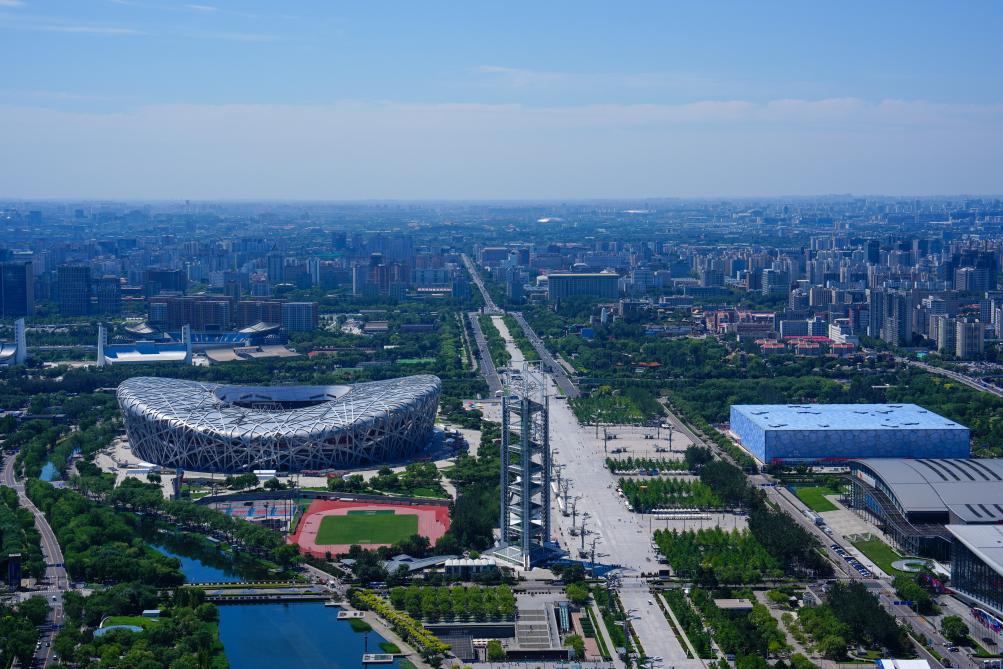
This photo taken on July 17, 2024 shows architectures along the Beijing Central Axis, with the Bird's Nest as well as the Water Cube on the extension of the axis, seen from the Olympic Tower in Beijing, capital of China. The United Nations Educational, Scientific and Cultural Organization (UNESCO) on Saturday announced the inclusion of the Beijing Central Axis: A Building Ensemble Exhibiting the Ideal Order of the Chinese Capital, into its world heritage list.
So far, China has a total of 59 World Heritage Sites.
Beijing Central Axis, initially established in the 13th century and formed in the 16th century, runs through the old city of Beijing from north to south. It has become the longest urban axis in the world today, spanning 7.8 kilometers.
The heritage area of the Beijing Central Axis covers 589 hectares, with a buffer zone of 4,542 hectares. Its location, layout, urban form, and design reflect the ancient Chinese tradition of urban planning, serving as an important emblem that highlights the distinctive characteristics of Chinese civilization. (Xinhua/Ju Huanzong)
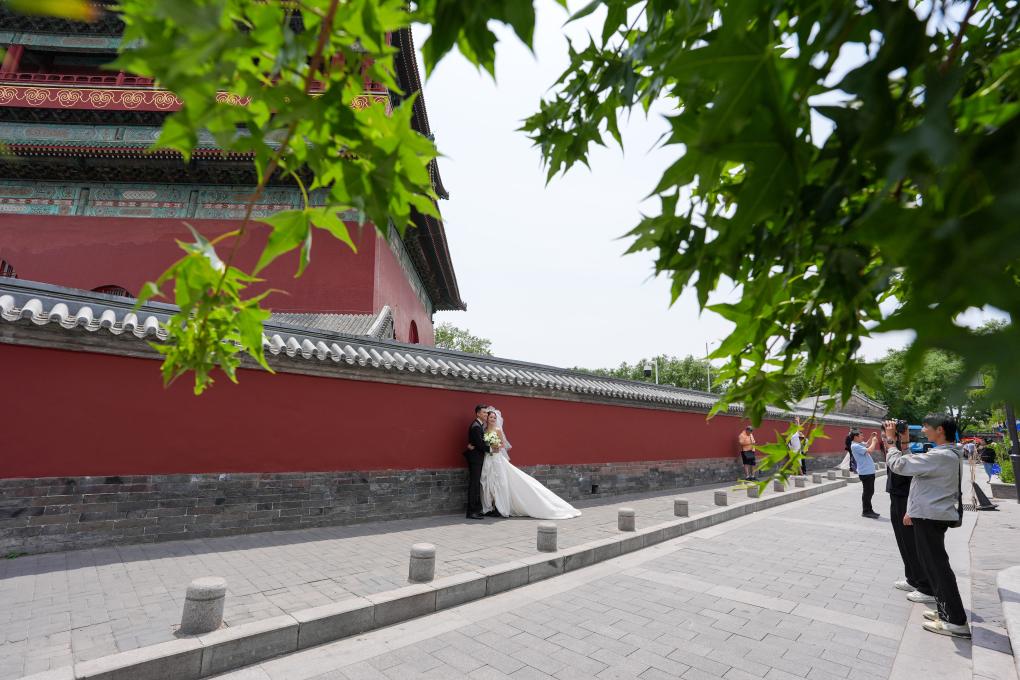
A couple pose for wedding photos near the Drum Tower in Beijing, capital of China, June 2, 2024. The United Nations Educational, Scientific and Cultural Organization (UNESCO) on Saturday announced the inclusion of the Beijing Central Axis: A Building Ensemble Exhibiting the Ideal Order of the Chinese Capital, into its world heritage list.
So far, China has a total of 59 World Heritage Sites.
Beijing Central Axis, initially established in the 13th century and formed in the 16th century, runs through the old city of Beijing from north to south. It has become the longest urban axis in the world today, spanning 7.8 kilometers.
The heritage area of the Beijing Central Axis covers 589 hectares, with a buffer zone of 4,542 hectares. Its location, layout, urban form, and design reflect the ancient Chinese tradition of urban planning, serving as an important emblem that highlights the distinctive characteristics of Chinese civilization. (Xinhua/Ju Huanzong)
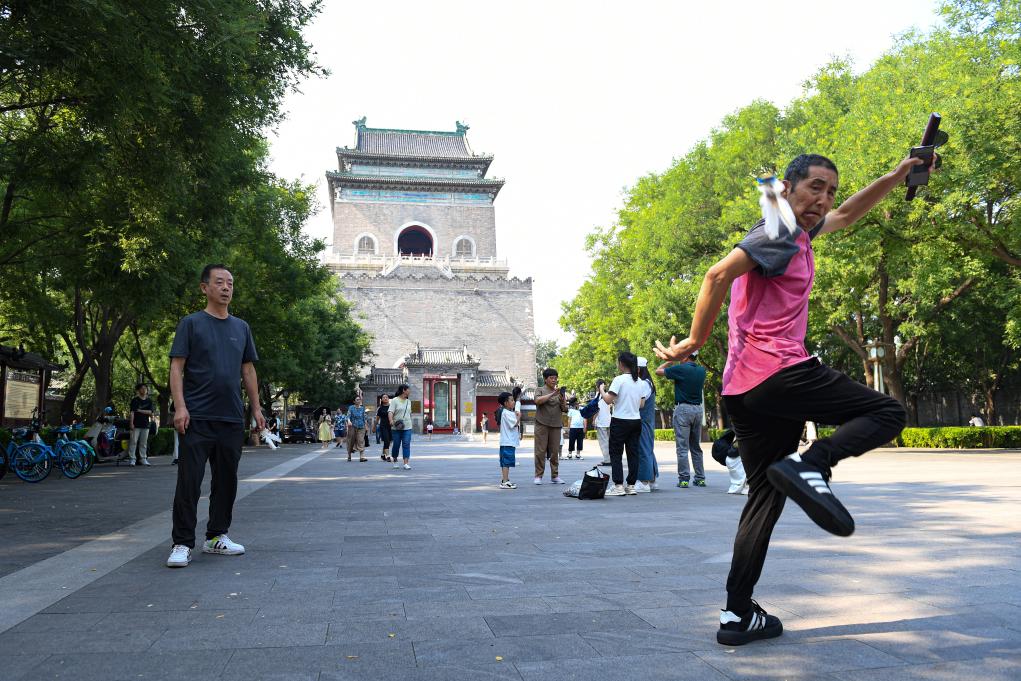
A citizen kicks shuttlecock at a square in front of the Bell and Drum Towers in Beijing, capital of China, July 3, 2024. The United Nations Educational, Scientific and Cultural Organization (UNESCO) on Saturday announced the inclusion of the Beijing Central Axis: A Building Ensemble Exhibiting the Ideal Order of the Chinese Capital, into its world heritage list.
So far, China has a total of 59 World Heritage Sites.
Beijing Central Axis, initially established in the 13th century and formed in the 16th century, runs through the old city of Beijing from north to south. It has become the longest urban axis in the world today, spanning 7.8 kilometers.
The heritage area of the Beijing Central Axis covers 589 hectares, with a buffer zone of 4,542 hectares. Its location, layout, urban form, and design reflect the ancient Chinese tradition of urban planning, serving as an important emblem that highlights the distinctive characteristics of Chinese civilization. (Xinhua/Chen Zhonghao)

This photo taken on July 20, 2024 shows the Bell and Drum Towers and the Jingshan Hill(R rear) in Beijing, capital of China. The United Nations Educational, Scientific and Cultural Organization (UNESCO) on Saturday announced the inclusion of the Beijing Central Axis: A Building Ensemble Exhibiting the Ideal Order of the Chinese Capital, into its world heritage list.
So far, China has a total of 59 World Heritage Sites.
Beijing Central Axis, initially established in the 13th century and formed in the 16th century, runs through the old city of Beijing from north to south. It has become the longest urban axis in the world today, spanning 7.8 kilometers.
The heritage area of the Beijing Central Axis covers 589 hectares, with a buffer zone of 4,542 hectares. Its location, layout, urban form, and design reflect the ancient Chinese tradition of urban planning, serving as an important emblem that highlights the distinctive characteristics of Chinese civilization. (Xinhua/Chen Zhonghao)
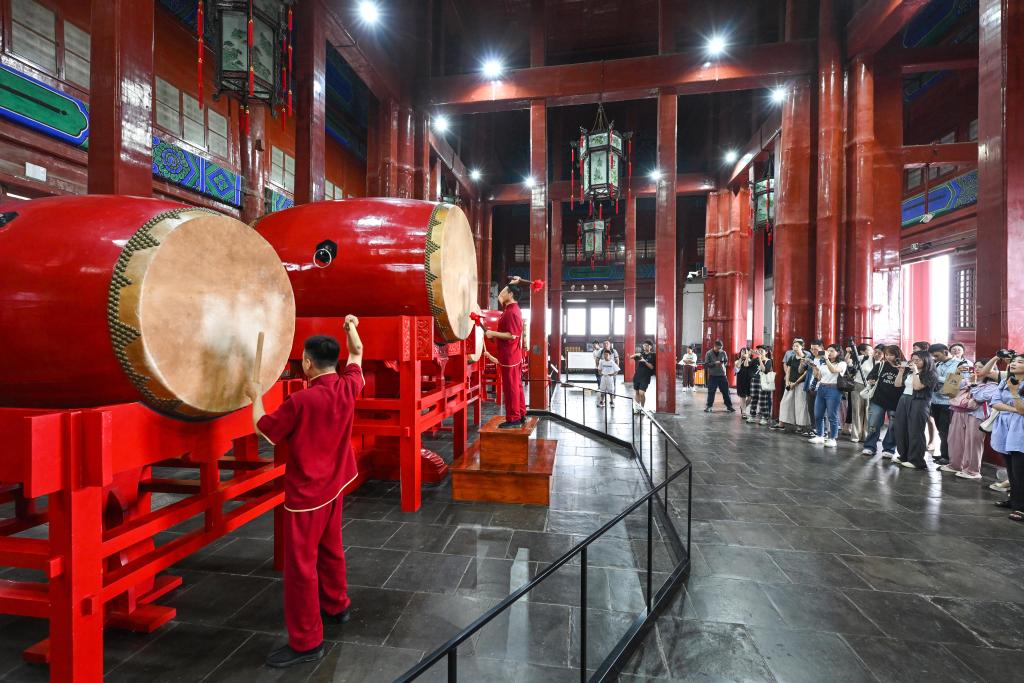
Tourists watch a drum performance at the Drum Tower in Beijing, capital of China, July 16, 2024. The United Nations Educational, Scientific and Cultural Organization (UNESCO) on Saturday announced the inclusion of the Beijing Central Axis: A Building Ensemble Exhibiting the Ideal Order of the Chinese Capital, into its world heritage list.
So far, China has a total of 59 World Heritage Sites.
Beijing Central Axis, initially established in the 13th century and formed in the 16th century, runs through the old city of Beijing from north to south. It has become the longest urban axis in the world today, spanning 7.8 kilometers.
The heritage area of the Beijing Central Axis covers 589 hectares, with a buffer zone of 4,542 hectares. Its location, layout, urban form, and design reflect the ancient Chinese tradition of urban planning, serving as an important emblem that highlights the distinctive characteristics of Chinese civilization. (Xinhua/Chen Yehua)

An ancient drum is pictured in the Drum Tower in Beijing, capital of China, July 16, 2024. The United Nations Educational, Scientific and Cultural Organization (UNESCO) on Saturday announced the inclusion of the Beijing Central Axis: A Building Ensemble Exhibiting the Ideal Order of the Chinese Capital, into its world heritage list.
So far, China has a total of 59 World Heritage Sites.
Beijing Central Axis, initially established in the 13th century and formed in the 16th century, runs through the old city of Beijing from north to south. It has become the longest urban axis in the world today, spanning 7.8 kilometers.
The heritage area of the Beijing Central Axis covers 589 hectares, with a buffer zone of 4,542 hectares. Its location, layout, urban form, and design reflect the ancient Chinese tradition of urban planning, serving as an important emblem that highlights the distinctive characteristics of Chinese civilization. (Xinhua/Chen Yehua)

People view models of the Bell and Drum Towers inside the Drum Tower in Beijing, capital of China, July 16, 2024. The United Nations Educational, Scientific and Cultural Organization (UNESCO) on Saturday announced the inclusion of the Beijing Central Axis: A Building Ensemble Exhibiting the Ideal Order of the Chinese Capital, into its world heritage list.
So far, China has a total of 59 World Heritage Sites.
Beijing Central Axis, initially established in the 13th century and formed in the 16th century, runs through the old city of Beijing from north to south. It has become the longest urban axis in the world today, spanning 7.8 kilometers.
The heritage area of the Beijing Central Axis covers 589 hectares, with a buffer zone of 4,542 hectares. Its location, layout, urban form, and design reflect the ancient Chinese tradition of urban planning, serving as an important emblem that highlights the distinctive characteristics of Chinese civilization. (Xinhua/Chen Yehua)

This photo taken on July 17, 2024 shows a caisson ceiling of the Longfu Temple displayed in the worship hall of the Altar of the God of Agriculture in Beijing, capital of China. The United Nations Educational, Scientific and Cultural Organization (UNESCO) on Saturday announced the inclusion of the Beijing Central Axis: A Building Ensemble Exhibiting the Ideal Order of the Chinese Capital, into its world heritage list.
So far, China has a total of 59 World Heritage Sites.
Beijing Central Axis, initially established in the 13th century and formed in the 16th century, runs through the old city of Beijing from north to south. It has become the longest urban axis in the world today, spanning 7.8 kilometers.
The heritage area of the Beijing Central Axis covers 589 hectares, with a buffer zone of 4,542 hectares. Its location, layout, urban form, and design reflect the ancient Chinese tradition of urban planning, serving as an important emblem that highlights the distinctive characteristics of Chinese civilization. (Xinhua/Zhang Chenlin)



